Paul van Yperen's Blog, page 397
December 22, 2014
Fred Louis Lerch
Austrian actor Fred Louis Lerch (1902-1985) was a handsome star of the Weimar cinema. In the 1950s he would work again for the German cinema as a production manager.
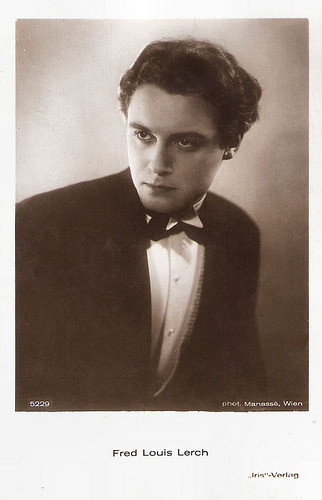
Austrian postcard by Iris Verlag, no. 5229. Photo: Manassé, Wien.
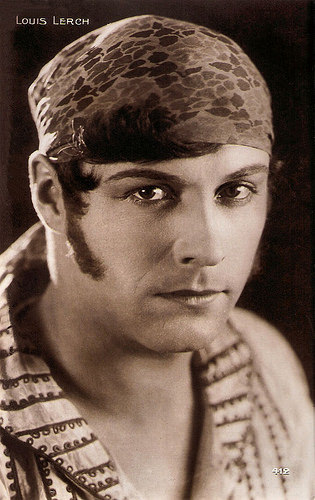
French postcard by Cinemagazine-Edition, no. 412.
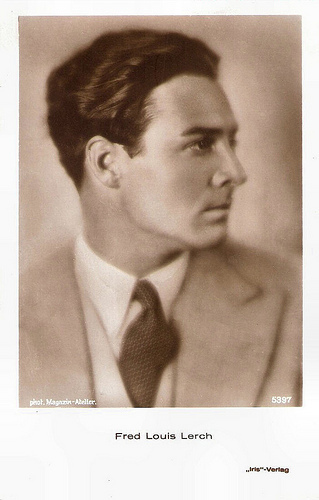
Austrian postcard by Iris Verlag, no. 5397. Photo: Magazin-Atelier.
Romantic Lover
Fred Louis Lerch was born as Alois Lerch in 1902 in Ernsdorf, Niederösterreich, Austria-Hungary (now Austria).
He began his career at the age of 20 with small parts in Austrian films like Die Menschen nennen es Liebe/People Call It Love (Nano Ziffer-Tesschenbruck, 1922), Opfer des Hasses/Sacrifice of Hate (Hanns Marschall, 1923), Das Bildnis/The Picture (Jacques Feyder, 1923), and Die Tochter der Frau von Larsac/The Daughter of mrs. von Larsac (Luise & Jakob Fleck, 1924).
He went on to star as the romantic lover in German and Austrian productions like Der Walzer von Strauß/Strauss' Waltz (Max Neufeld, 1925), Carmen (Jacques Feyder, 1926) with Raquel Meller , the comedy Der Jüngling aus der Konfektion/The Young Man From Confection (Richard Löwenbein, 1926), and the Arthur Schitzler adaptation Liebelei/Flirtation (Luise & Jakob Fleck, 1926).
In Sweden he acted as Louis Lerch in Förseglade läppar/Sealed Lips (Gustaf Molander, 1927) based on a story by Guy de Maupausant, and with Ruth Weyher and Margit Manstad in the eternal triangle drama Parisiskor/Doctors' Women (Gustaf Molander, 1927).
From then on he solely worked in Germany. He starred with Lya Mara in Heut tanzt Mariett/Today Mariett Dances (Friedrich Zelnik - later Frederic Zelnik, 1928), followed by two films directed by Richard Eichberg, Rutschbahn/Whirl of Youth (1928) with Fee Malten and Heinrich George , and the stylish Großstadtschmetterling/City Butterfly (1928) starring the Chinese-American Hollywood star Anna May Wong.
Among his other silent films were Mary Lou (Friedrich Zelnik, 1928), and the Edgar Wallace adaptation Der rote Kreis/The Crimson Circle (Friedrich Zelnik, 1929) both again with Lya Mara .
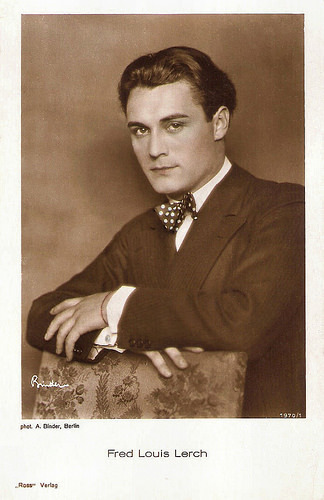
German postcard by Ross Verlag, no. 1970/1, 1927-1928. Photo: Alex Binder, Berlin.
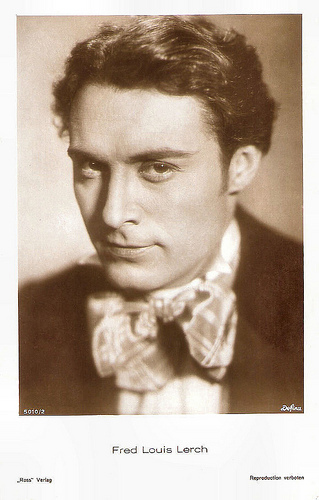
German postcard by Ross Verlag, no. 5010/2, 1930-1931. Photo: Defina.
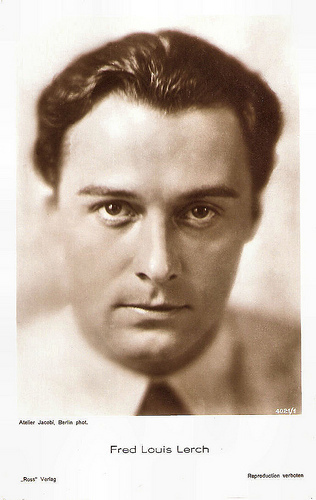
German postcard by Ross Verlag, no. 4021/1, 1929-1930. Photo: Atelier Jacobi, Berlin.
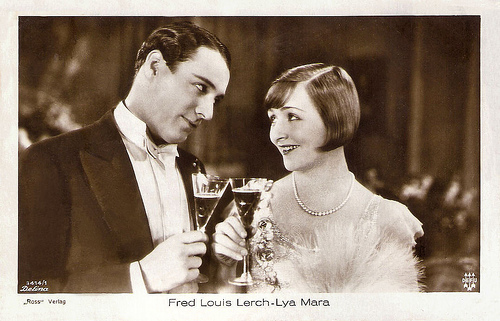
German postcard by Ross Verlag, no. 3414/1, 1928-1929. Photo: Defina / DEFU. Publicity still for Heut tanzt Mariett/Today dances Mariett (Friedrich Zelnik, 1928) with Lya Mara . Collection: Egbert Barten.
Production Manager
When the sound film came to stay, the career of the then 29 year old Fred Louis Lerch halted. The naturalistic actor appeared only in front of the camera in small parts in films like the British-German coproduction The Flame of Love (Richard Eichberg, Walter Cummings, 1930) – again with Anna May Wong, Student sein wenn die Veilchen blühen/Student Life in Marry Springtime (Heinz Paul, 1930) with Anita Dorris , and the comedy Um eine Nasenlänge/By a Nose (Johannes Guter, 1931) with Sig Arno.
His last film was Die vom 17er Haus/Those From the 17th House (Artur Berger, 1932).
Twenty years later he returned to the film business. As a production or unit manager he worked from 1951 till 1961 for several German film companies. Among these films were many Heimatfilms like Hochzeitsglocken/Wedding Bells (Georg Wildhagen, 1953) starring Marianne Hoppe , and Der Meineidbauer/The Perjury Farmer (Rudolf Jugert, 1956) starring Carl Wery and Heidemarie Hatheyer .
Fred Louis Lerch died in 1985 in München (Munich), Germany, at the age of 83. He was married to actress Grete Reinwald.
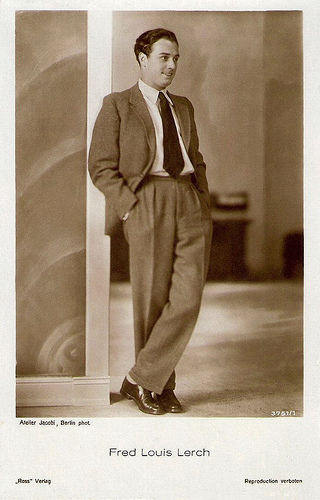
German postcard by Ross Verlag, no. 3751/1, 1928-1929. Photo: Atelier Jacobi, Berlin.
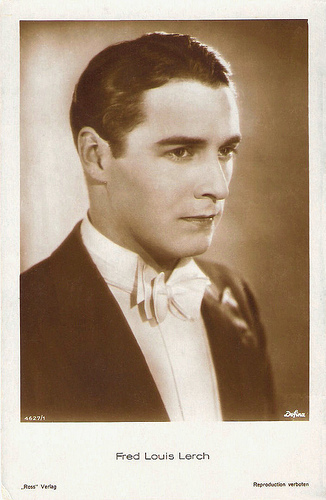
German postcard by Ross Verlag, no. 4627/1, 1929-1930. Photo: Defina.
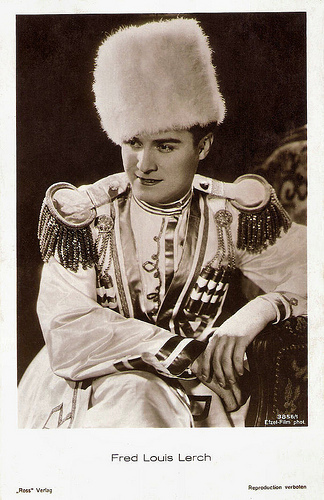
German postcard by Ross Verlag, no. 3856/1, 1928-1929. Photo: Efzet-Film. Publicity still for Der rote Kreis/The Crimson Circle (Friedrich Zelnik, 1929).
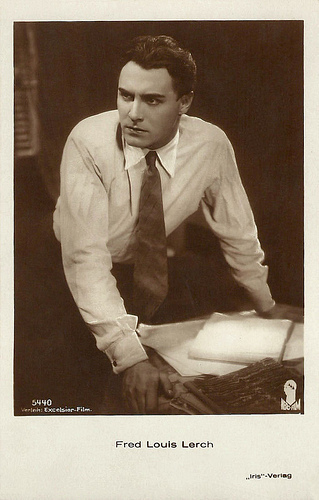
Austrian postcard by Iris Verlag, no. 5440. Photo: Nero-Film / Excelsior-Film. Collection: Didier Hanson.
Sources: Thomas Staedeli (Cyranos), Filmportal.de, , and .

Austrian postcard by Iris Verlag, no. 5229. Photo: Manassé, Wien.

French postcard by Cinemagazine-Edition, no. 412.

Austrian postcard by Iris Verlag, no. 5397. Photo: Magazin-Atelier.
Romantic Lover
Fred Louis Lerch was born as Alois Lerch in 1902 in Ernsdorf, Niederösterreich, Austria-Hungary (now Austria).
He began his career at the age of 20 with small parts in Austrian films like Die Menschen nennen es Liebe/People Call It Love (Nano Ziffer-Tesschenbruck, 1922), Opfer des Hasses/Sacrifice of Hate (Hanns Marschall, 1923), Das Bildnis/The Picture (Jacques Feyder, 1923), and Die Tochter der Frau von Larsac/The Daughter of mrs. von Larsac (Luise & Jakob Fleck, 1924).
He went on to star as the romantic lover in German and Austrian productions like Der Walzer von Strauß/Strauss' Waltz (Max Neufeld, 1925), Carmen (Jacques Feyder, 1926) with Raquel Meller , the comedy Der Jüngling aus der Konfektion/The Young Man From Confection (Richard Löwenbein, 1926), and the Arthur Schitzler adaptation Liebelei/Flirtation (Luise & Jakob Fleck, 1926).
In Sweden he acted as Louis Lerch in Förseglade läppar/Sealed Lips (Gustaf Molander, 1927) based on a story by Guy de Maupausant, and with Ruth Weyher and Margit Manstad in the eternal triangle drama Parisiskor/Doctors' Women (Gustaf Molander, 1927).
From then on he solely worked in Germany. He starred with Lya Mara in Heut tanzt Mariett/Today Mariett Dances (Friedrich Zelnik - later Frederic Zelnik, 1928), followed by two films directed by Richard Eichberg, Rutschbahn/Whirl of Youth (1928) with Fee Malten and Heinrich George , and the stylish Großstadtschmetterling/City Butterfly (1928) starring the Chinese-American Hollywood star Anna May Wong.
Among his other silent films were Mary Lou (Friedrich Zelnik, 1928), and the Edgar Wallace adaptation Der rote Kreis/The Crimson Circle (Friedrich Zelnik, 1929) both again with Lya Mara .

German postcard by Ross Verlag, no. 1970/1, 1927-1928. Photo: Alex Binder, Berlin.

German postcard by Ross Verlag, no. 5010/2, 1930-1931. Photo: Defina.

German postcard by Ross Verlag, no. 4021/1, 1929-1930. Photo: Atelier Jacobi, Berlin.

German postcard by Ross Verlag, no. 3414/1, 1928-1929. Photo: Defina / DEFU. Publicity still for Heut tanzt Mariett/Today dances Mariett (Friedrich Zelnik, 1928) with Lya Mara . Collection: Egbert Barten.
Production Manager
When the sound film came to stay, the career of the then 29 year old Fred Louis Lerch halted. The naturalistic actor appeared only in front of the camera in small parts in films like the British-German coproduction The Flame of Love (Richard Eichberg, Walter Cummings, 1930) – again with Anna May Wong, Student sein wenn die Veilchen blühen/Student Life in Marry Springtime (Heinz Paul, 1930) with Anita Dorris , and the comedy Um eine Nasenlänge/By a Nose (Johannes Guter, 1931) with Sig Arno.
His last film was Die vom 17er Haus/Those From the 17th House (Artur Berger, 1932).
Twenty years later he returned to the film business. As a production or unit manager he worked from 1951 till 1961 for several German film companies. Among these films were many Heimatfilms like Hochzeitsglocken/Wedding Bells (Georg Wildhagen, 1953) starring Marianne Hoppe , and Der Meineidbauer/The Perjury Farmer (Rudolf Jugert, 1956) starring Carl Wery and Heidemarie Hatheyer .
Fred Louis Lerch died in 1985 in München (Munich), Germany, at the age of 83. He was married to actress Grete Reinwald.

German postcard by Ross Verlag, no. 3751/1, 1928-1929. Photo: Atelier Jacobi, Berlin.

German postcard by Ross Verlag, no. 4627/1, 1929-1930. Photo: Defina.

German postcard by Ross Verlag, no. 3856/1, 1928-1929. Photo: Efzet-Film. Publicity still for Der rote Kreis/The Crimson Circle (Friedrich Zelnik, 1929).

Austrian postcard by Iris Verlag, no. 5440. Photo: Nero-Film / Excelsior-Film. Collection: Didier Hanson.
Sources: Thomas Staedeli (Cyranos), Filmportal.de, , and .
Published on December 22, 2014 22:00
December 21, 2014
Billie Whitelaw (1932-2014)
Acclaimed British actress Billie Whitelaw, famous for her roles on stage and screen, has died yesterday at the age of 82. The Coventry-born star, who was made a CBE in 1991, worked in close collaboration with playwright Samuel Beckett, who described her as a perfect actress. She gained an international audience for her role as the chilling Mrs Baylock in the horror film The Omen.
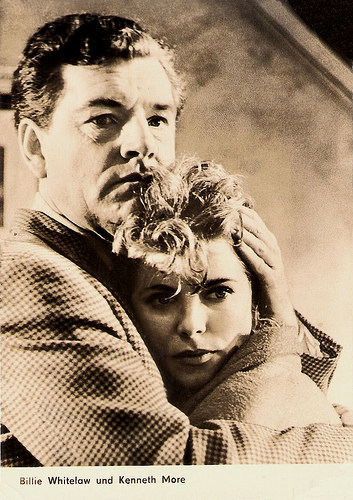
East-German postcard by VEB Progress Filmvertrieb, Berlin, no. 2420, 1965. Photo: publicity still for The Comedy Man (Alvin Rakoff, 1964) featuring Kenneth More.
Willowy good looks
Billie Honor Whitelaw was born in Coventry on 6 June 1932. Her family moved to Bradford to escape German bombing. Her father died from lung cancer there when his daughter was just 10.
When the young Billie developed a stutter, her mother enrolled her in a local drama group in an effort to boost her daughter's confidence. Her drama training secured her some spots on BBC North's Children's Hour. Her stage debut came at the Prince's Theatre, Bradford, in a 1950 performance of Pink String and Sealing Wax.
Her willowy good looks also made her something of a regular face in British films of the decade. She made her film debut in Joseph Losey's first British feature The Sleeping Tiger (1954), followed by roles in the war drama Carve Her Name With Pride (Lewis Gilbert, 1958) and Hell Is a City (Val Guest, 1960), starring Stanley Baker .
After working with Joan Littlewood's Theatre Workshop she joined the National Theatre, playing Desdemona to Laurence Olivier's Othello at the Chichester Festival in 1964.
Billie Whitelaw met the Irish playwright Samuel Beckett, with whom she would enjoy a 26-year professional relationship. She became his muse. He would write parts in experimental plays for her which she would often perform to the point of exhaustion.
Her first performance in a Beckett work was Play, which had its London debut in 1964. Many of the parts were physically and emotionally demanding. In Happy Days she was buried up to her waist in sand for her performance.
She stopped performing Beckett's works when he died in 1989 but she remained the keeper of his flame through her one-woman lecture tours.
In 1966, she divorced her first husband, actor Peter Vaughan, bringing to an end what had become an increasingly troubled relationship.
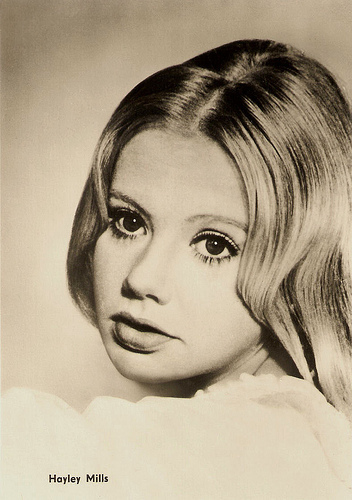
Hayley Mills . East-German postcard by VEB Progress Film-Vertrieb, Berlin, no. 3042, 1968. Photo: Warner Bros.
Chilling nanny
In the mid1960s, Billie Whitelaw was attracting bigger film parts. There were Baftas for her performance opposite Albert Finney in Charlie Bubbles (Albert Finney, 1967) and for her role as the mother of Hayley Mills in the psychological thriller, Twisted Nerve (Roy Boulting, 1968).
Billie Whitelaw won much acclaim for her portrayal of Mrs Baylock, the chilling nanny of the demon child Damien in The Omen (Richard Donner, 1976). Many critics felt she gave the best performance in the film and it won her an Evening Standard Award for Best Actress.
She also won praise for her role as the fiercely domineering and protective mother of the psychopathic Kray twins in The Krays (Peter Medak, 1990), which featured Spandau Ballet's Martin and Gary Kemp as her notorious sons.
After she stopped in the theatre, she did continue to act in films, such as in Quills (Philip Kaufman, 2000) with Geoffrey Rush and Kate Winslet) and the comedy Hot Fuzz (Edgar Wright, 2007). During her career, she appeared in more than 50 films.
Billie Whitelaw also found happiness with the writer and actor Robert Muller, whom she met in 1967 and with whom she had a son. Robert Muller died in 1998.
Whitelaw spent her final four years in Denville Hall, the retirement home for actors in north London, which was supported by Richard Attenborough . She died there in the early hours of Sunday 21 December 2014.
Trailer for Hell Is a City (1960). Source: leatherface1111 (YouTube).
Trailer for The Omen (1976). Source: Video Detective (YouTube).
Sources: Kevin Rawlinson (The Guardian), BBC, Wikipedia and .

East-German postcard by VEB Progress Filmvertrieb, Berlin, no. 2420, 1965. Photo: publicity still for The Comedy Man (Alvin Rakoff, 1964) featuring Kenneth More.
Willowy good looks
Billie Honor Whitelaw was born in Coventry on 6 June 1932. Her family moved to Bradford to escape German bombing. Her father died from lung cancer there when his daughter was just 10.
When the young Billie developed a stutter, her mother enrolled her in a local drama group in an effort to boost her daughter's confidence. Her drama training secured her some spots on BBC North's Children's Hour. Her stage debut came at the Prince's Theatre, Bradford, in a 1950 performance of Pink String and Sealing Wax.
Her willowy good looks also made her something of a regular face in British films of the decade. She made her film debut in Joseph Losey's first British feature The Sleeping Tiger (1954), followed by roles in the war drama Carve Her Name With Pride (Lewis Gilbert, 1958) and Hell Is a City (Val Guest, 1960), starring Stanley Baker .
After working with Joan Littlewood's Theatre Workshop she joined the National Theatre, playing Desdemona to Laurence Olivier's Othello at the Chichester Festival in 1964.
Billie Whitelaw met the Irish playwright Samuel Beckett, with whom she would enjoy a 26-year professional relationship. She became his muse. He would write parts in experimental plays for her which she would often perform to the point of exhaustion.
Her first performance in a Beckett work was Play, which had its London debut in 1964. Many of the parts were physically and emotionally demanding. In Happy Days she was buried up to her waist in sand for her performance.
She stopped performing Beckett's works when he died in 1989 but she remained the keeper of his flame through her one-woman lecture tours.
In 1966, she divorced her first husband, actor Peter Vaughan, bringing to an end what had become an increasingly troubled relationship.

Hayley Mills . East-German postcard by VEB Progress Film-Vertrieb, Berlin, no. 3042, 1968. Photo: Warner Bros.
Chilling nanny
In the mid1960s, Billie Whitelaw was attracting bigger film parts. There were Baftas for her performance opposite Albert Finney in Charlie Bubbles (Albert Finney, 1967) and for her role as the mother of Hayley Mills in the psychological thriller, Twisted Nerve (Roy Boulting, 1968).
Billie Whitelaw won much acclaim for her portrayal of Mrs Baylock, the chilling nanny of the demon child Damien in The Omen (Richard Donner, 1976). Many critics felt she gave the best performance in the film and it won her an Evening Standard Award for Best Actress.
She also won praise for her role as the fiercely domineering and protective mother of the psychopathic Kray twins in The Krays (Peter Medak, 1990), which featured Spandau Ballet's Martin and Gary Kemp as her notorious sons.
After she stopped in the theatre, she did continue to act in films, such as in Quills (Philip Kaufman, 2000) with Geoffrey Rush and Kate Winslet) and the comedy Hot Fuzz (Edgar Wright, 2007). During her career, she appeared in more than 50 films.
Billie Whitelaw also found happiness with the writer and actor Robert Muller, whom she met in 1967 and with whom she had a son. Robert Muller died in 1998.
Whitelaw spent her final four years in Denville Hall, the retirement home for actors in north London, which was supported by Richard Attenborough . She died there in the early hours of Sunday 21 December 2014.
Trailer for Hell Is a City (1960). Source: leatherface1111 (YouTube).
Trailer for The Omen (1976). Source: Video Detective (YouTube).
Sources: Kevin Rawlinson (The Guardian), BBC, Wikipedia and .
Published on December 21, 2014 23:00
Udo Jürgens (1934-2014)
Udo Jürgens, one of the biggest stars and entertainers in the German speaking countries, died yesterday, 21 December 2014. His music spanned several generations. In 1966, he was the first and only Austrian winner of the Eurovision Song Contest with Merci, Chérie. The Austrian composer and singer has written more than 800 songs and sold over 100 million records. He also appeared in some light entertainment films during the 1950s and 1960s. Jürgens collapsed while out for a walk near his Switzerland home. He died of heart failure in a hospital in Münsterlingen, Switzerland. Udo Jürgens was 80 years old.
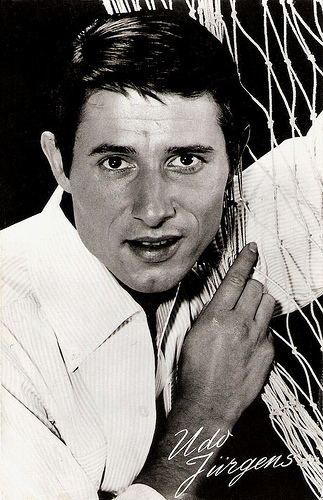
Dutch postcard by Uitg. en druk. 't Sticht, Utrecht, no. AX 6560.

Spanish postcard by Oscarcolor, no. 373.
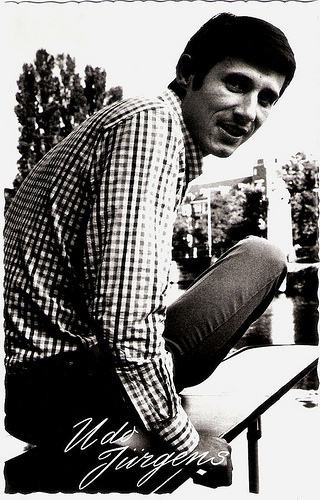
German postcard by Filmbilder-Vertrieb Ernst Freithoff, Essen, no. 6926.
Cross-Dressing Farces
Udo Jürgens was born as Udo Jürgen Bockelmann in Klagenfurt, Austria in 1934. His wealthy family lived in Schloss Ottmanach (Ottmanach Castle), where he grew up with his brothers John, later a businessman, and Manfred, now a respected painter.
In 1948, Udo started studying piano, harmony, composition and singing at the Conservatory of Klagenfurt. Just 16, he won a composer contest organized by Austria's public broadcasting channel ORF with the song Je t'aime (1950). His success built from there over the next decade.
In 1957 he performed a song in the Schlagerfilm Die Beine von Dolores/Night Club (Géza von Cziffra, 1957) starring Germaine Damar , and a year later he appeared in the crime comedy Lilli - ein Mädchen aus der Großstadt/Lilli, a girl from the big city (Hermann Leitner, 1958) with Adrian Hoven .
He was one of the participants of the German delegation that won the Knokke Song festival in Belgium in 1960. His song Jenny became a number 1 hit in the Belgian charts.
In 1961, he wrote the worldwide hit Reach for the Stars, sung by Shirley Bassey. That year he appeared in the Schlagerfilm Und du mein Schatz bleibst hier/And you My Dear, stay here (Franz Antel, 1961), starring Vivi Bach .
The following years he could be seen in more of such mediocre fare, like in the cross-dressing farces Unsere tollen Tanten/Our Great Aunts (Rolf Olsen, 1961), Unsere tollen Tanten in der Südsee/Our Great Aunts in the Southsea (Rolf Olsen, 1963), Unsere tollen Nichten/Our Great Nieces (Rolf Olsen, 1963) all co-starring Günther Philipp and Gus Backus , and Drei Liebesbriefe aus Tirol/Three love letters from Tyrol (Werner Jacobs, 1962) with Ann Smyrner .
In 1964, he represented Austria for the first time at the Eurovision Song Contest with the song Warum nur warum?, finishing sixth. The UK participant, Matt Monro, was impressed with the melody and covered the song with English lyrics as Walk Away. This version reached number four in the UK Singles Chart and number 23 in the US Billboard Hot 100.
Jürgens' song Sag ihr, ich lass sie grüßen came fourth in 1965's contest. In 1966 he finally won the Eurovision Song Contest with Merci, Chérie. This song became an English-language hit for Vince Hill, another cover by Monro, and one of Jürgens' most recognized compositions. Jürgens' version alone sold over one million copies, and he was awarded a gold disc by Deutsche Vogue.
In 1966, he also played in the Italian-German musical La battaglia dei mods/Crazy Baby (Franco Montemurro, 1966) with Ricky Shayne . But the following decades he mostly appeared on TV for the cameras.
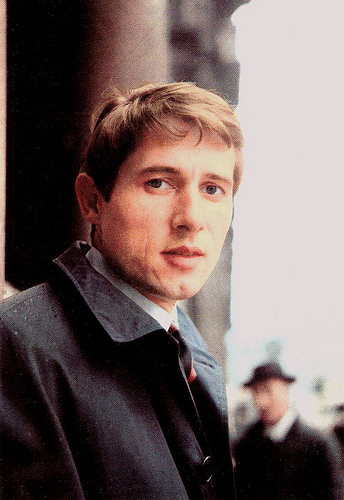
Italian postcard. Photo: SAAR.

German postcard by Filmbilder-Vertrieb Ernst Freihoff, Essen, no. AX 7081. Photo: Ariola.
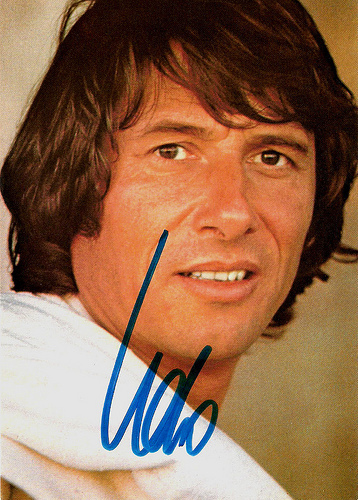
Swiss promotion card by Ariola. Photo: M. Bockelmann.
The Man With The Bassoon
During the 1970s, Udo Jürgens wrote some of his most famous songs, like Griechischer Wein (1975, Come Share The Wine), Aber bitte mit Sahne (1977, I'll have whipped cream with that), and Mit 66 Jahren (1978, At 66). He is credited with broadening German-language pop music beyond the traditional post-war Schlager by infusing it with a modern pop appeal.
One of his biggest successes was Buenos Días, Argentina, which he performed together with the German national football team in 1978. In 1979, he released a disco album entitled Udo '80. It produced a hit song Ich weiß was ich will (I Know What I Want).
The following Udo ’80 tour became with 330.000 visitors in 110 concerts his most successful concert tour till then. Three years later he broke this record with more than 400.000 visitors in 123 concerts. And his Ohne Maske tour in 1989 attracted 410.000 visitors during 107 concerts. A new record made his 1994-1995 tour with about 500.000 visitors in 140 concerts.
In 2007, the musical Ich war noch niemals in New York (I've never been to New York) opened in Hamburg's Operettenhaus. It weaved songs by Jürgens into a familial storyline. In 2011 he played the lead in the TV mini-series Der Mann mit dem Fagott/The man with the bassoon (Miguel Alexandre, 2011). The mini-series was based on Jürgens’ own autobiographical novel and won two awards in Germany and Austria.
Udo Jürgens’ exceptionally tuneful compositions and sophisticated arrangements continue to attract fans of all ages. Even in his 70’s he filled the largest concert venues in Germany, Austria, and Switzerland.
He married and divorced twice: first to Erika Meier (1964-1989) and then to Corinna Reinhold (1999-2006). He had two children from his first marriage, singer, actor and DJ John Jürgens (1964), and actress Jenny Jürgens (1967). He also had two illegitimate children, Sonja and actress Gloria Burda.
Scene from Unsere tollen Tanten/Our Great Aunts (1961) with Trude Herr. Source: Sablinef (YouTube).
Udo Jürgens sings Nobody knows the trouble I've seen & Maria (1966). Source: Fritz 51139 (YouTube).
Udo Jürgens sings Merci Cherie at the Eurovision Song Contest in 1966. Source: Escbelgium3 (YouTube).
Sources: Dave Thompson (AllMusic), Udo Jürgens.de, Wikipedia and .

Dutch postcard by Uitg. en druk. 't Sticht, Utrecht, no. AX 6560.

Spanish postcard by Oscarcolor, no. 373.

German postcard by Filmbilder-Vertrieb Ernst Freithoff, Essen, no. 6926.
Cross-Dressing Farces
Udo Jürgens was born as Udo Jürgen Bockelmann in Klagenfurt, Austria in 1934. His wealthy family lived in Schloss Ottmanach (Ottmanach Castle), where he grew up with his brothers John, later a businessman, and Manfred, now a respected painter.
In 1948, Udo started studying piano, harmony, composition and singing at the Conservatory of Klagenfurt. Just 16, he won a composer contest organized by Austria's public broadcasting channel ORF with the song Je t'aime (1950). His success built from there over the next decade.
In 1957 he performed a song in the Schlagerfilm Die Beine von Dolores/Night Club (Géza von Cziffra, 1957) starring Germaine Damar , and a year later he appeared in the crime comedy Lilli - ein Mädchen aus der Großstadt/Lilli, a girl from the big city (Hermann Leitner, 1958) with Adrian Hoven .
He was one of the participants of the German delegation that won the Knokke Song festival in Belgium in 1960. His song Jenny became a number 1 hit in the Belgian charts.
In 1961, he wrote the worldwide hit Reach for the Stars, sung by Shirley Bassey. That year he appeared in the Schlagerfilm Und du mein Schatz bleibst hier/And you My Dear, stay here (Franz Antel, 1961), starring Vivi Bach .
The following years he could be seen in more of such mediocre fare, like in the cross-dressing farces Unsere tollen Tanten/Our Great Aunts (Rolf Olsen, 1961), Unsere tollen Tanten in der Südsee/Our Great Aunts in the Southsea (Rolf Olsen, 1963), Unsere tollen Nichten/Our Great Nieces (Rolf Olsen, 1963) all co-starring Günther Philipp and Gus Backus , and Drei Liebesbriefe aus Tirol/Three love letters from Tyrol (Werner Jacobs, 1962) with Ann Smyrner .
In 1964, he represented Austria for the first time at the Eurovision Song Contest with the song Warum nur warum?, finishing sixth. The UK participant, Matt Monro, was impressed with the melody and covered the song with English lyrics as Walk Away. This version reached number four in the UK Singles Chart and number 23 in the US Billboard Hot 100.
Jürgens' song Sag ihr, ich lass sie grüßen came fourth in 1965's contest. In 1966 he finally won the Eurovision Song Contest with Merci, Chérie. This song became an English-language hit for Vince Hill, another cover by Monro, and one of Jürgens' most recognized compositions. Jürgens' version alone sold over one million copies, and he was awarded a gold disc by Deutsche Vogue.
In 1966, he also played in the Italian-German musical La battaglia dei mods/Crazy Baby (Franco Montemurro, 1966) with Ricky Shayne . But the following decades he mostly appeared on TV for the cameras.

Italian postcard. Photo: SAAR.

German postcard by Filmbilder-Vertrieb Ernst Freihoff, Essen, no. AX 7081. Photo: Ariola.

Swiss promotion card by Ariola. Photo: M. Bockelmann.
The Man With The Bassoon
During the 1970s, Udo Jürgens wrote some of his most famous songs, like Griechischer Wein (1975, Come Share The Wine), Aber bitte mit Sahne (1977, I'll have whipped cream with that), and Mit 66 Jahren (1978, At 66). He is credited with broadening German-language pop music beyond the traditional post-war Schlager by infusing it with a modern pop appeal.
One of his biggest successes was Buenos Días, Argentina, which he performed together with the German national football team in 1978. In 1979, he released a disco album entitled Udo '80. It produced a hit song Ich weiß was ich will (I Know What I Want).
The following Udo ’80 tour became with 330.000 visitors in 110 concerts his most successful concert tour till then. Three years later he broke this record with more than 400.000 visitors in 123 concerts. And his Ohne Maske tour in 1989 attracted 410.000 visitors during 107 concerts. A new record made his 1994-1995 tour with about 500.000 visitors in 140 concerts.
In 2007, the musical Ich war noch niemals in New York (I've never been to New York) opened in Hamburg's Operettenhaus. It weaved songs by Jürgens into a familial storyline. In 2011 he played the lead in the TV mini-series Der Mann mit dem Fagott/The man with the bassoon (Miguel Alexandre, 2011). The mini-series was based on Jürgens’ own autobiographical novel and won two awards in Germany and Austria.
Udo Jürgens’ exceptionally tuneful compositions and sophisticated arrangements continue to attract fans of all ages. Even in his 70’s he filled the largest concert venues in Germany, Austria, and Switzerland.
He married and divorced twice: first to Erika Meier (1964-1989) and then to Corinna Reinhold (1999-2006). He had two children from his first marriage, singer, actor and DJ John Jürgens (1964), and actress Jenny Jürgens (1967). He also had two illegitimate children, Sonja and actress Gloria Burda.
Scene from Unsere tollen Tanten/Our Great Aunts (1961) with Trude Herr. Source: Sablinef (YouTube).
Udo Jürgens sings Nobody knows the trouble I've seen & Maria (1966). Source: Fritz 51139 (YouTube).
Udo Jürgens sings Merci Cherie at the Eurovision Song Contest in 1966. Source: Escbelgium3 (YouTube).
Sources: Dave Thompson (AllMusic), Udo Jürgens.de, Wikipedia and .
Published on December 21, 2014 15:30
December 20, 2014
Anna Prucnal
Beautiful Polish actress Anna Prucnal (1940) was a star of the East-European cinema of the 1960s. From 1970 on, she worked in France as an actress as well as a successful singer. Her role in the controversial and shocking film Sweet Movie (1974) caused her to be banned from her homeland for 15 years.
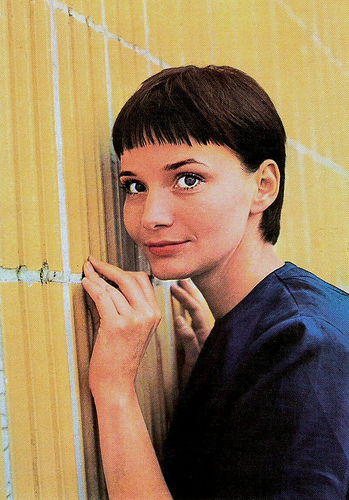
East-German postcard by VEB Progress Film-Vertrieb, Berlin, no. 2259, 1965. Retail price: 0,15 MDN. Photo: Schwarz.
Centre of Intellectual Challenge
Anna Prucnal was born in Warsaw, Poland, in 1940.
Her father, a surgeon of Jewish-gypsy origin, was killed by the Nazis during the Second World War. Anna was then raised, along with her sister, solely by her mother. Her mother was related to Stanislas Leszczyński: an 18th century King of Poland.
After studying piano and lyrical song, Anna went on to pursue an acting career in Warsaw. She started acting at the student theatre group STS, a centre of intellectual challenge in Warsaw.
Her first film appearance was in the Bulgarian film Slăntzeto i siankata/Sun and Shadow (Rangel Vulchanov, 1962), which made her immediately popular all over Eastern-Europe.
Next she played in various East-European productions. In the Polish Smarkula/Teenager (Leonard Buczkowski, 1963) she appeared as a teenage girl, lost in Warsaw.
In East-Germany she appeared opposite Fred Düren in the DEFA production Der fliegende Holländer/The Flying Dutchman (Joachim Herz, 1964). Another DEFA production was the comedy Reise ins Ehebett/Journey into the Nuptial Bed (Joachim Hasler, 1966) with Eva-Maria Hagen .
In Poland she worked with the famous director Andrzej Wajda on the short TV film Przekladaniec/Layer Cake (Andrzej Wajda, 1968), the story of a racing car driver who undergoes so many transplants that it can no longer be determined which people have contributed to his make-up.
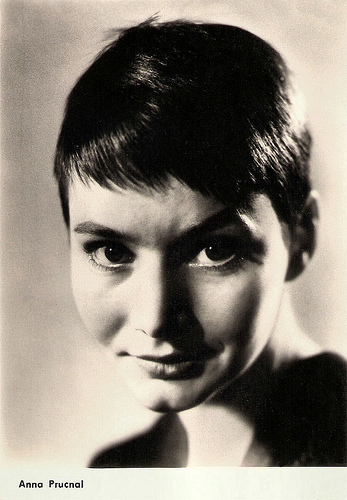
East-German postcard by VEB Progress Film-Vertrieb, Berlin, no. 2.039, 1964. Retail price: 0,20 MDN. Photo: Karin Blasig.
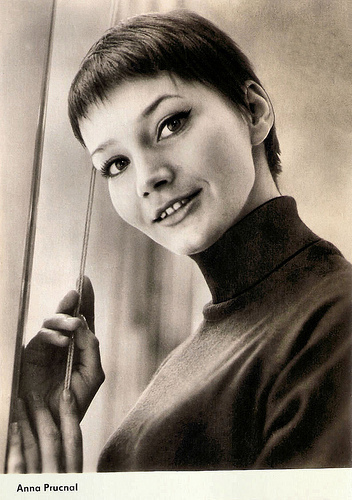
East-German postcard by VEB Progress Film-Vertrieb, Berlin, no. 2512, 1965. Retail price: 0,20 MDN. Photo: Balinski.
Notorious
Anna Prucnal moved to France in 1970 and embarked upon a theatrical career, appearing in a number of plays by Bertolt Brecht. She worked with many important stage directors including: Georges Wilson, Roger Planchon, and Jean-Louis Barrault .
During this time she also appeared in several films, including Hellé (Roger Vadim, 1972) and the TV film Un jeune homme seul (Jean Mailland, 1974).
Notorious was Sweet Movie (Dusan Makavejev, 1974) in which she co-starred with Carole Laure and Pierre Clementi. Nathan Southern at AllMovie explains: “Like his WR: Mysteries of the Organism, Dusan Makavejev's controversial 1974 feature Sweet Movie is firmly rooted in the principles of psychoanalyst Wilhelm Reich. In cinematic terms, this means bombarding the audience with an onset of imagery so visceral, disgusting and repellent that it ‘awakens’ the viewer in a Brechtian manner by ‘short-circuiting’ the audience's reactions.”
At IMDb , Yngvar Myrvold writes: “It brings to memory the golden days of the early 70's, when radical sex and politics thrived in the cinemas along with traditional Hollywood-fare, and movies were still considered dangerous and subversive. The movie itself is funny, tasteless, allegorical and even has glorious in-jokes. Like the river-boat Potemkin sailing down the Seine with the enormous head of Lenin in the prow.”
At the time Polish authorities were not amused and deemed the film to be pornographic and anti-communist. As a result, Prucnal was banned from using her Polish passport by the repressive authorities of the time – effectively exiling her from her homeland.
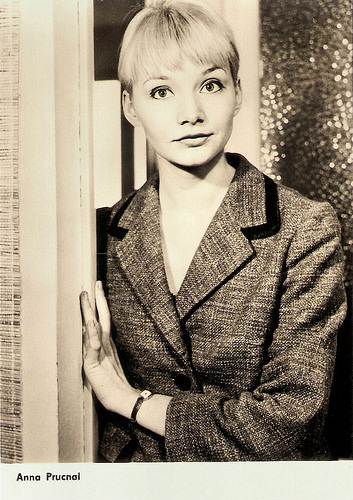
East-German postcard by VEB Progress Film-Vertrieb, Berlin, no. 2875, 1967. Retail price: 0,20 MDN. Photo: Balinski.

East-German postcard by VEB Progress Film-Vertrieb, Berlin, no. 3001, 1967. Retail price: 0,20 MDN. Photo: Balinski.
Fellini
In 1978 Anna Prucnal started a new career as a singer. Her album Rêve d'Ouest-Rêve d'Est (Dream of West, Dream of East) proved to be popular. Initially she performed it during recitals in Paris, later in Belgium and then worldwide. After 15 years, she returned to Warsaw for a recital to celebrate the bicentenary of the French revolution in 1989.
Since then Anna Prucnal has continued to release records such as Monsieur Brecht in 2006. She also appeared in films as the crime drama Le dossier 51/Dossier 51 (Michel Deville, 1978) and in Mais où et donc Ornicar/Glass Cages (Bertrand Van Effenterre, 1979) with Geraldine Chaplin . The French film title is a sentence learnt in school to remember the conjunctions in French grammar: mais, ou, et, donc, or, ni, car (mais où et donc ornicar?).
In Fellini’s wonderful La città delle donne/City of Women (Federico Fellini, 1980), she played Marcello Mastroianni’s former wife.
Prucnal also regularly appeared on French TV such as in the series V comme vengeance/V for Vengeance (1989-1992).
During the 1990s she played again in Polish films such as Obywatel swiata (Roland Rowinski, 1991), Lepiej byc piekna i bogata/Better to Be Pretty and Rich (Filip Bajon, 1993) with Daniel Olbrychski , and Wrony/The Crows (Dorota Kedzierzawska, 1994) about a young girl who mimics a crow.
Her most recent film is the French Le stade de Wimbledon/Wimbledon Stage (Mathieu Amalric, 2001).
On stage she appeared in La Voix humaine (The Human Voice) by Jean Cocteau and Francis Poulenc, under the direction of her life partner Jean Mailland in 1993, and in the acclaimed play The Vagina Monologues by Eve Ensler in 2005.
In 2002, Anna Prucnal published her autobiography entitled Moi qui suis née à Varsovie (I, who was born in Warsaw). She and Jean Mailland have a son, Pierre.
The boat entrance scene in Sweet Movie (1974) with Anna Prucnal and Pierre Clementi. Source: rqwxyz (YouTube).
Anna Prucnal sings Quand on n'a que l'amour by Jacques Brel and Élisabeth by Jean Mailland and Francis Lai. Source: Nina fan 1968 (YouTube).
Sources: Nathan Southern (AllMovie), Yngvar Myrvold (IMDb), Wikipedia and .

East-German postcard by VEB Progress Film-Vertrieb, Berlin, no. 2259, 1965. Retail price: 0,15 MDN. Photo: Schwarz.
Centre of Intellectual Challenge
Anna Prucnal was born in Warsaw, Poland, in 1940.
Her father, a surgeon of Jewish-gypsy origin, was killed by the Nazis during the Second World War. Anna was then raised, along with her sister, solely by her mother. Her mother was related to Stanislas Leszczyński: an 18th century King of Poland.
After studying piano and lyrical song, Anna went on to pursue an acting career in Warsaw. She started acting at the student theatre group STS, a centre of intellectual challenge in Warsaw.
Her first film appearance was in the Bulgarian film Slăntzeto i siankata/Sun and Shadow (Rangel Vulchanov, 1962), which made her immediately popular all over Eastern-Europe.
Next she played in various East-European productions. In the Polish Smarkula/Teenager (Leonard Buczkowski, 1963) she appeared as a teenage girl, lost in Warsaw.
In East-Germany she appeared opposite Fred Düren in the DEFA production Der fliegende Holländer/The Flying Dutchman (Joachim Herz, 1964). Another DEFA production was the comedy Reise ins Ehebett/Journey into the Nuptial Bed (Joachim Hasler, 1966) with Eva-Maria Hagen .
In Poland she worked with the famous director Andrzej Wajda on the short TV film Przekladaniec/Layer Cake (Andrzej Wajda, 1968), the story of a racing car driver who undergoes so many transplants that it can no longer be determined which people have contributed to his make-up.

East-German postcard by VEB Progress Film-Vertrieb, Berlin, no. 2.039, 1964. Retail price: 0,20 MDN. Photo: Karin Blasig.

East-German postcard by VEB Progress Film-Vertrieb, Berlin, no. 2512, 1965. Retail price: 0,20 MDN. Photo: Balinski.
Notorious
Anna Prucnal moved to France in 1970 and embarked upon a theatrical career, appearing in a number of plays by Bertolt Brecht. She worked with many important stage directors including: Georges Wilson, Roger Planchon, and Jean-Louis Barrault .
During this time she also appeared in several films, including Hellé (Roger Vadim, 1972) and the TV film Un jeune homme seul (Jean Mailland, 1974).
Notorious was Sweet Movie (Dusan Makavejev, 1974) in which she co-starred with Carole Laure and Pierre Clementi. Nathan Southern at AllMovie explains: “Like his WR: Mysteries of the Organism, Dusan Makavejev's controversial 1974 feature Sweet Movie is firmly rooted in the principles of psychoanalyst Wilhelm Reich. In cinematic terms, this means bombarding the audience with an onset of imagery so visceral, disgusting and repellent that it ‘awakens’ the viewer in a Brechtian manner by ‘short-circuiting’ the audience's reactions.”
At IMDb , Yngvar Myrvold writes: “It brings to memory the golden days of the early 70's, when radical sex and politics thrived in the cinemas along with traditional Hollywood-fare, and movies were still considered dangerous and subversive. The movie itself is funny, tasteless, allegorical and even has glorious in-jokes. Like the river-boat Potemkin sailing down the Seine with the enormous head of Lenin in the prow.”
At the time Polish authorities were not amused and deemed the film to be pornographic and anti-communist. As a result, Prucnal was banned from using her Polish passport by the repressive authorities of the time – effectively exiling her from her homeland.

East-German postcard by VEB Progress Film-Vertrieb, Berlin, no. 2875, 1967. Retail price: 0,20 MDN. Photo: Balinski.

East-German postcard by VEB Progress Film-Vertrieb, Berlin, no. 3001, 1967. Retail price: 0,20 MDN. Photo: Balinski.
Fellini
In 1978 Anna Prucnal started a new career as a singer. Her album Rêve d'Ouest-Rêve d'Est (Dream of West, Dream of East) proved to be popular. Initially she performed it during recitals in Paris, later in Belgium and then worldwide. After 15 years, she returned to Warsaw for a recital to celebrate the bicentenary of the French revolution in 1989.
Since then Anna Prucnal has continued to release records such as Monsieur Brecht in 2006. She also appeared in films as the crime drama Le dossier 51/Dossier 51 (Michel Deville, 1978) and in Mais où et donc Ornicar/Glass Cages (Bertrand Van Effenterre, 1979) with Geraldine Chaplin . The French film title is a sentence learnt in school to remember the conjunctions in French grammar: mais, ou, et, donc, or, ni, car (mais où et donc ornicar?).
In Fellini’s wonderful La città delle donne/City of Women (Federico Fellini, 1980), she played Marcello Mastroianni’s former wife.
Prucnal also regularly appeared on French TV such as in the series V comme vengeance/V for Vengeance (1989-1992).
During the 1990s she played again in Polish films such as Obywatel swiata (Roland Rowinski, 1991), Lepiej byc piekna i bogata/Better to Be Pretty and Rich (Filip Bajon, 1993) with Daniel Olbrychski , and Wrony/The Crows (Dorota Kedzierzawska, 1994) about a young girl who mimics a crow.
Her most recent film is the French Le stade de Wimbledon/Wimbledon Stage (Mathieu Amalric, 2001).
On stage she appeared in La Voix humaine (The Human Voice) by Jean Cocteau and Francis Poulenc, under the direction of her life partner Jean Mailland in 1993, and in the acclaimed play The Vagina Monologues by Eve Ensler in 2005.
In 2002, Anna Prucnal published her autobiography entitled Moi qui suis née à Varsovie (I, who was born in Warsaw). She and Jean Mailland have a son, Pierre.
The boat entrance scene in Sweet Movie (1974) with Anna Prucnal and Pierre Clementi. Source: rqwxyz (YouTube).
Anna Prucnal sings Quand on n'a que l'amour by Jacques Brel and Élisabeth by Jean Mailland and Francis Lai. Source: Nina fan 1968 (YouTube).
Sources: Nathan Southern (AllMovie), Yngvar Myrvold (IMDb), Wikipedia and .
Published on December 20, 2014 22:00
December 19, 2014
La canzone dell’amore (1930)
This week's film special is about the first Italian sound film, La canzone dell’amore/The Song of Love (1930) directed by Gennaro Righelli. Lead actors of this popular sob story were Dria Paola, Elio Steiner and Isa Pola. Dria Paola became a star overnight.
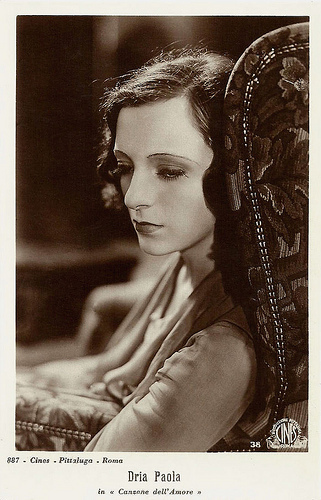
Italian postcard by G.B. Falci, Milano, no. 887. Photo: Cines Pittaluga, Roma, no. 38. Publicity still of Dria Paola in La canzone dell’amore (1930).
Quite Absurd Story
La canzone dell’amore/The Song of Love (Gennaro Righelli, 1930) was the first Italian sound feature - released in Italy and entirely produced in Italy. It was distributed by Societa Anonima Stefano Pittaluga and produced by Società Italiana Cines.
Alessandro Blasetti's Resurrectio/The Resurrection was in fact the first sound film produced in Italy, but it was only released in 1931. Allegedly because La canzone dell’amore was thought to be more commercial, and indeed, Resurrectio became a box-office flop.
The quite absurd story of La canzone dell’amore is about a young woman who adopts the baby her mother gave birth to. It was based very loosely on a short story by Luigi Pirandello, In silenzio (In Silence).
While her widowed mother dies giving birth, music student Lucia ( Dria Paola ) adopts little Ninni, pretending to her fiancé Enrico (Elio Steiner) and her landlady it is her own child.
Lucia breaks up her engagement with Enrico, who is about to become a big musician. Lucia’s rival Anna, played by another upcoming star: Isa Pola , gets hold of Enrico. But when Lucia and Enrico later on meet in the big record store where Lucia works and where Enrico is making a record, he admits he still loves her.
The father of the child ( Camillo Pilotto ) shows up and claims the child. Heartbroken, Lucia gives in but tries to commit suicide afterwards. Just in time Enrico saves her, the father gives the child to Lucia and all is well.
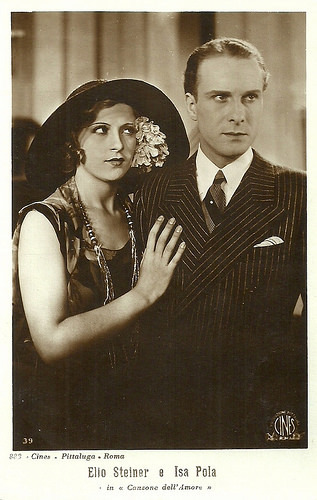
Italian postcard by G.B. Falci, Milano, no. 888. Photo: Cines Pittaluga, Roma, no. 39. Isa Pola and Elio Steiner in La canzone dell'amore (Gennaro Righelli, 1930).
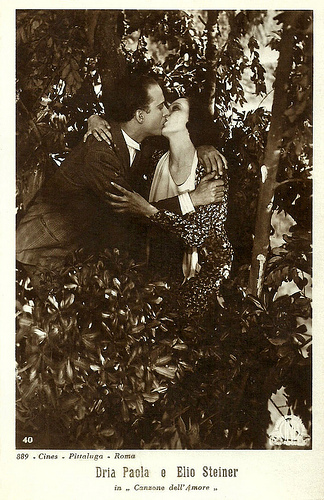
Italian postcard by G.B. Falci, Milano, no. 889. Photo: Cines Pittaluga, Roma, no. 40. Lucia ( Dria Paola ) and Enrico (Elio Steiner) hide from their friends in order to be able to kiss each other, in La canzone dell’amore (1930).
Double Framing
La canzone dell’amore opens and closes with images of Rome, and is actually one of the few Italian films from the 1930s showing the city repeatedly.
Stylistically important are the different moments of double framing, when Lucia looks out from her rented rooms and mimics neighbours how to change diapers and feed the child. Interesting is also Righelli’s visualisation of Lucia’s frenzy at her suicide attempt and his pans across the enormous set of the record store.
La canzone dell’amore had its premiere on 7 October 1930 at the Supercinema in Rome, the actual Teatro Nazionale. The film was a popular success, not in the least because of the music composed by Cesare Andrea Bixio, whose well-known song Solo per te Lucia became a hit as well.
Gerald A. DeLuca at IMDb : "Although laced with elements of soap opera, the film is nicely acted and manages to engross the viewer so that one really cares about what happens to this poor woman and her 'son' that she has grown to love. The boy, at the age of 14 months, is played by this sweetheart of a kid named Nello Rocchi. The film has some genuinely touching moments. My favorite one is when Lucia is at a loss about how to change and diaper the child on her first day with him. She looks out the apartment window across the way at another mom who is bathing, changing, and nursing her own child. Lucia imitates what the other mother is doing as though the neighbor were providing how-to instructions in motherhood. The only thing she cannot imitate is the breast-feeding; Lucia ponders the difference between herself and her neighbor, then grabs the baby-bottle to feed little Ninní. All this is accompanied by a lovely ninna-nanna in the background."
The film also had two alternate-language versions, one in German, Liebes Lied (Constantin J. Davis, 1931) starring Gustav Fröhlich and Renate Müller , and one in French, La dernière berceuse (Jean Cassagne, 1931) with Jean Angelo and Dolly Davis .
Lead actress Dria Paola became a star overnight. But soon the thin actress with the big head and fluttering hands was type casted as the fragile and sometimes clumsy damsel in distress. She could never repeat the success of her first sound film, and retired in the 1940s.
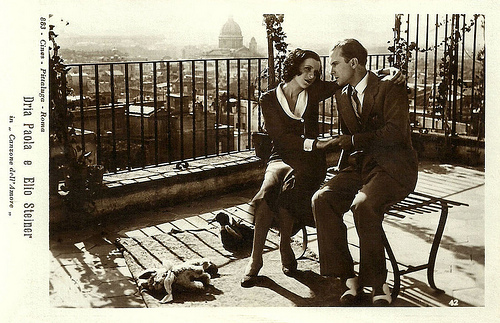
Italian postcard by G.B. Falci, Milano, no. 883. Photo: Cines Pittaluga, Roma, no. 40. After an attempted suicide, Lucia ( Dria Paola ) and Enrico (Elio Steiner) make up towards the end of La canzone dell’amore (1930). The cityscape of Rome in the background.
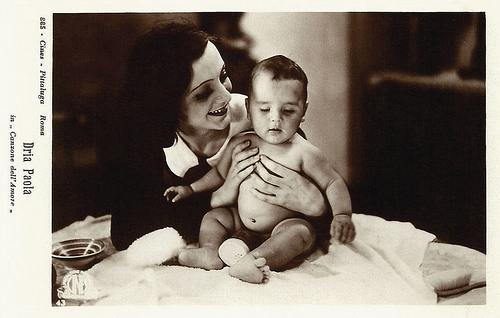
Italian postcard by G.B. Falci, Milano, no. 885. Photo: Cines Pittaluga, Roma, no. 43. Publicity still of Dria Paola in La canzone dell’amore (1930).
Sources: Wikipedia (Italian), and IMDb.

Italian postcard by G.B. Falci, Milano, no. 887. Photo: Cines Pittaluga, Roma, no. 38. Publicity still of Dria Paola in La canzone dell’amore (1930).
Quite Absurd Story
La canzone dell’amore/The Song of Love (Gennaro Righelli, 1930) was the first Italian sound feature - released in Italy and entirely produced in Italy. It was distributed by Societa Anonima Stefano Pittaluga and produced by Società Italiana Cines.
Alessandro Blasetti's Resurrectio/The Resurrection was in fact the first sound film produced in Italy, but it was only released in 1931. Allegedly because La canzone dell’amore was thought to be more commercial, and indeed, Resurrectio became a box-office flop.
The quite absurd story of La canzone dell’amore is about a young woman who adopts the baby her mother gave birth to. It was based very loosely on a short story by Luigi Pirandello, In silenzio (In Silence).
While her widowed mother dies giving birth, music student Lucia ( Dria Paola ) adopts little Ninni, pretending to her fiancé Enrico (Elio Steiner) and her landlady it is her own child.
Lucia breaks up her engagement with Enrico, who is about to become a big musician. Lucia’s rival Anna, played by another upcoming star: Isa Pola , gets hold of Enrico. But when Lucia and Enrico later on meet in the big record store where Lucia works and where Enrico is making a record, he admits he still loves her.
The father of the child ( Camillo Pilotto ) shows up and claims the child. Heartbroken, Lucia gives in but tries to commit suicide afterwards. Just in time Enrico saves her, the father gives the child to Lucia and all is well.

Italian postcard by G.B. Falci, Milano, no. 888. Photo: Cines Pittaluga, Roma, no. 39. Isa Pola and Elio Steiner in La canzone dell'amore (Gennaro Righelli, 1930).

Italian postcard by G.B. Falci, Milano, no. 889. Photo: Cines Pittaluga, Roma, no. 40. Lucia ( Dria Paola ) and Enrico (Elio Steiner) hide from their friends in order to be able to kiss each other, in La canzone dell’amore (1930).
Double Framing
La canzone dell’amore opens and closes with images of Rome, and is actually one of the few Italian films from the 1930s showing the city repeatedly.
Stylistically important are the different moments of double framing, when Lucia looks out from her rented rooms and mimics neighbours how to change diapers and feed the child. Interesting is also Righelli’s visualisation of Lucia’s frenzy at her suicide attempt and his pans across the enormous set of the record store.
La canzone dell’amore had its premiere on 7 October 1930 at the Supercinema in Rome, the actual Teatro Nazionale. The film was a popular success, not in the least because of the music composed by Cesare Andrea Bixio, whose well-known song Solo per te Lucia became a hit as well.
Gerald A. DeLuca at IMDb : "Although laced with elements of soap opera, the film is nicely acted and manages to engross the viewer so that one really cares about what happens to this poor woman and her 'son' that she has grown to love. The boy, at the age of 14 months, is played by this sweetheart of a kid named Nello Rocchi. The film has some genuinely touching moments. My favorite one is when Lucia is at a loss about how to change and diaper the child on her first day with him. She looks out the apartment window across the way at another mom who is bathing, changing, and nursing her own child. Lucia imitates what the other mother is doing as though the neighbor were providing how-to instructions in motherhood. The only thing she cannot imitate is the breast-feeding; Lucia ponders the difference between herself and her neighbor, then grabs the baby-bottle to feed little Ninní. All this is accompanied by a lovely ninna-nanna in the background."
The film also had two alternate-language versions, one in German, Liebes Lied (Constantin J. Davis, 1931) starring Gustav Fröhlich and Renate Müller , and one in French, La dernière berceuse (Jean Cassagne, 1931) with Jean Angelo and Dolly Davis .
Lead actress Dria Paola became a star overnight. But soon the thin actress with the big head and fluttering hands was type casted as the fragile and sometimes clumsy damsel in distress. She could never repeat the success of her first sound film, and retired in the 1940s.

Italian postcard by G.B. Falci, Milano, no. 883. Photo: Cines Pittaluga, Roma, no. 40. After an attempted suicide, Lucia ( Dria Paola ) and Enrico (Elio Steiner) make up towards the end of La canzone dell’amore (1930). The cityscape of Rome in the background.

Italian postcard by G.B. Falci, Milano, no. 885. Photo: Cines Pittaluga, Roma, no. 43. Publicity still of Dria Paola in La canzone dell’amore (1930).
Sources: Wikipedia (Italian), and IMDb.
Published on December 19, 2014 22:00
December 18, 2014
Virna Lisi (1936-2014)
On 17 December 2014, Virna Lisi passed away at the age of 78. The seductive Italian actress appeared in more than 100 film and TV productions and is internationally best known as a tempting blue-eyed blonde in Hollywood productions of the 1960s. But she proved to be more than a pretty face. From the late 1970s, she had a career Renaissance with three-dimensional character parts in a wide variety of Italian and French films. A triumph was her portrayal of a malevolent Catherine de Medici in La Reine Margot (1994) for which she won both the David di Donatello and the César award. Yesterday, Italian media quoted her son as saying that Lisi had passed away peacefully in her sleep, a month after being diagnosed with an incurable illness.
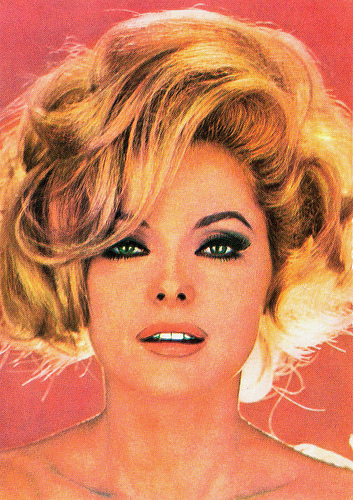
Romanian postcard by Casa Filmului Acin. Retail price: 2 Lei.
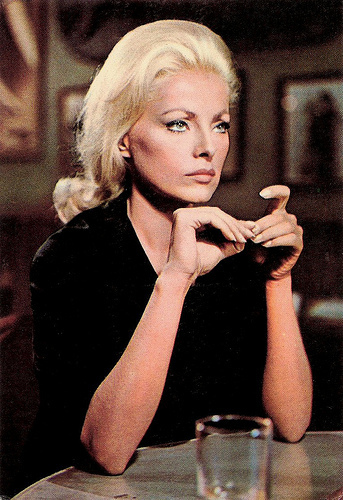
Italian postcard. Photo: Paramount. Publicity still for Assault on a Queen (Jack Donohue, 1966).
With Such A Mouth...
Virna Lisi was born as Virna Lisa Pieralisi in Ancona, Italy in 1936. Her father had a marble exporting business on the Adriatic coast. Her brother, Ubaldo Pieralisi, later became a talent agent, and her sister Esperia Pieralisi also became an actress.
Virna began her film career as a teenager. She was discovered by two Neapolitan producers, Antonio Ferrigno and Ettore Pesce, in Paris. Her debut was in La corda d'acciaio/The line of steel (Carlo Borghesio, 1953-1958).
Initially, she did musical films, like E Napoli canta/Napoli sings (Armando Grottini, 1953) and the successful four-episode film Questa è la vita/Such is life (Luigi Zampa a.o., 1954), with the popular Totò .
Her looks were more valued than her talent in some of her early films, like in Le diciottenni/Eighteen Year Olds (Mario Mattoli, 1955) with Marisa Allasio , and Lo scapolo/The Bachelor (Antonio Pietrangeli, 1955) with Alberto Sordi .
She incarnated more demanding roles in Il cardinale Lambertini/Cardinal Lambertini (Giorgio Pastina, 1954) opposite Gino Cervi , La Donna del Giorno/The Doll That Took the Town (Francesco Maselli, 1956), the peplum Romolo e Remo/Duel of the Titans (Sergio Corbucci, 1961) featuring musclemen Steve Reeves and Gordon Scott as the two legendary brothers Romulus and Remus, and Eva/Eve (Joseph Losey, 1962) starring Jeanne Moreau .
In the late 1950s, Lisi played on stage at the Piccolo Teatro di Milano, and appeared in I giacobini by Federico Zardi, under the direction of Giorgio Strehler.
During the 1960s, she performed in stage comedies and she also participated in some very popular television dramas. On TV she also promoted a toothpaste brand, with a slogan which would become a catchphrase amongst the Italians: "con quella bocca può dire ciò che vuole" (with such a mouth, she can say whatever she wants).

Italian postcard by Rotalcolor, Milano, no. 660.

East-German postcard by VEB Progress Filmvertrieb, Berlin, no. 2481, 1965. Photo: publicity still for La tulipe noire/The Black Tulip (Christian-Jacque, 1964) with Alain Delon and Virna Lisi.
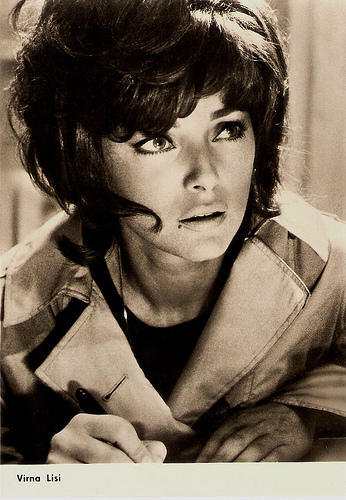
East-German postcard by VEB Progress Film-Vertrieb, Berlin, no. 2869. Retail price: 0,20 MDN.
Tempting Blue-eyed Blonde
In France, Virna Lisi played the role that brought her first international attention, in La tulipe noire/The Black Tulip (Christian-Jacque, 1964). As the heroine to Alain Delon ’s dashing swashbuckler, she combined sexiness with dexterity.
In the 1960s, Hollywood producers were looking for a successor to Marilyn Monroe and so Lisi then made a dent in Hollywood comedies as a tempting blue-eyed blonde.
She first starred opposite Jack Lemmon in George Axelrod’s satirical How to Murder Your Wife (Richard Quine, 1965). At IMDb, reviewer Mdantonio takes his hat off for her performance: “What most everyone fails to mention in the comments is the incredible skill of Virna Lisi. She is a natural mixing it up with Lemmon, (Claire) Trevor and the other veterans like she had been making movies for years. I have watched many movies in my day and I must say that Virna Lisi is right at the top, not only in beauty and sexuality but in carrying her role as good as anyone else could have. Ms. Lisi, my hat is off to you.”
Lisi also gained attention with the March 1965 cover of Esquire magazine on which she was shaving her face. The following year she appeared in another comedy, Not with My Wife, You Don't! (Norman Panama, 1966) now with Tony Curtis.
She also starred with Frank Sinatra in Assault on a Queen (Jack Donohue, 1966), with Rod Steiger in La Ragazza e il Generale/The Girl and the General (Pasquale Festa Campanile, 1967), and twice with Anthony Quinn, in the war drama La vingt-cinquième heure/The 25th Hour (Henri Verneuil, 1967), and in The Secret of Santa Vittoria (Stanley Kramer, 1969).
John Francis Lane in his obituary in The Guardian : "Though she enjoyed her American experiences and appreciated the professionalism she encountered, Lisi soon tired of the 'new Marilyn' image foisted upon her. She accepted becoming a cover girl but refused a lucrative offer to pose for Playboy."
To overcome her typecasting as a sexy, seductive woman, Lisi sought new types of roles, and found these in such Italian comedies as Le bambole/Four Kinds of Love (Dino Risi a.o., 1965), Signore & signori/The Birds, the Bees and the Italians (Pietro Germi, 1966) and Le dolci signore/Anyone Can Play (Fausto Saraceni, Luigi Zampa, 1968), and Roma bene (Carlo Lizzani, 1971) with Senta Berger .
At AllMovie , Robert Firsching reviews Signore & signori: “Pietro Germi's funny anthology combines the standard sex comedy format with some unexpectedly subtle observations about village life. The film centers on three stories exposing the sexual secrets of the Italian town of Treviso. (...) Signore e Signori won the Best Film award at the 1966 Cannes Film Festival.”
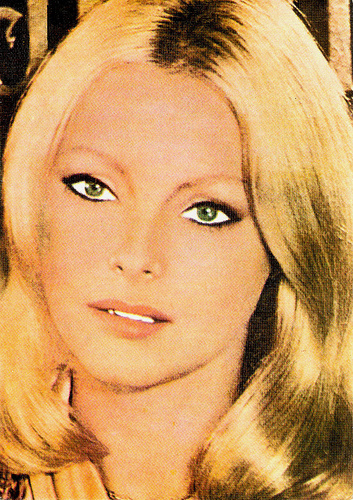
Romanian postcard by Casa Filmului Acin, no. 43078.
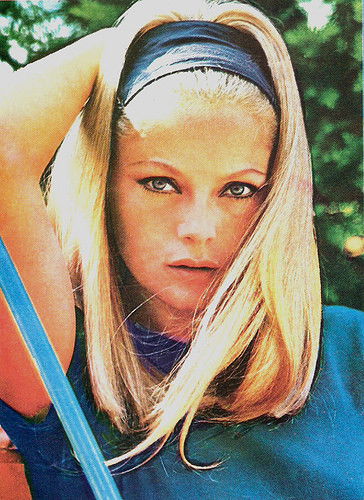
Yugoslavian postcard by Cik Razglednica.
Career Renaissance
In the early 1970s, Virna Lisi decided to focus on her family, husband Franco Pesci and her son Corrado, born in 1962.
In the later 1970s she had a career renaissance with a series of major Italian films. She played Friedrich Nietzsche’s neurotic sister, Elisabeth, in the controversial Al di là del bene e del male/Beyond Good and Evil (Liliana Cavani, 1977) starring Dominique Sanda .
It was followed by roles in Ernesto (Salvatore Samperi, 1979), La cicala/The Cricket (Alberto Lattuada, 1980), and I ragazzi di via Panisperna/The Boys of the Via Panisperna (Gianni Amelio, 1989) with Andrea Prodan and Mario Adorf .
Andrea Prodan’s brother Luca Prodan is the singer of the Argentinean band Sumo which made a song for Lisi. The Brazilian rock band Virna Lisi is even named after her.
Her greatest triumph was the French film La Reine Margot/Queen Margot (Patrice Chéreau, 1994) in which Lisi played a malevolent Catherine de Medici, ordering assaults, poisonings, and instigations to incest.
Karl Williams writes at AllMovie : “The historical novel by Alexandre Dumas was adapted for the screen with this lavish French epic, winner of 5 Césars and a pair of awards at the Cannes Film Festival. Isabelle Adjani stars as Marguerite de Valois, better known as Margot, daughter of scheming Catholic power player Catherine de Medici (Virna Lisi).”
For her magnificent portrayal Lisi won the César and the Best Actress award in Cannes, and also the David di Donatello award, the Italian equivalent of the Oscar.
Since the late 1990s, she did many successful dramatic TV productions, including L'onore e il rispetto/Honour and respect (Salvatore Samperi, 2006) with Gabriel Garko and Giancarlo Giannini.
In 2002, Lisi starred in Il più bel giorno della mia vita/The Best Day of My Life (Cristina Comencini, 2002) with Margherita Buy, and she reunited with director Cristina Comencini for her final film, the comedy Latin Lover, which will be released next year.
Since 1960, Virna Lisi was married to architect Franco Pesci, who died last year. She is survived by her son Corrado and three grandchildren: Franco, Federico and Riccardo.
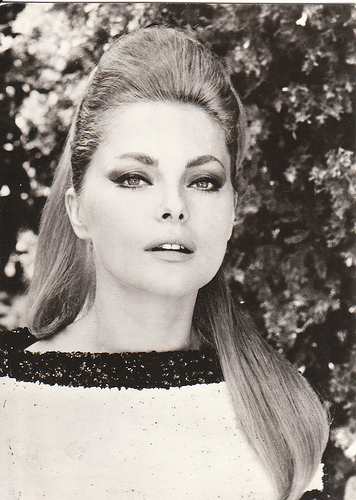
Romanian postcard by Casa Filmului Acin. Collection: Veronique3@Flickr.
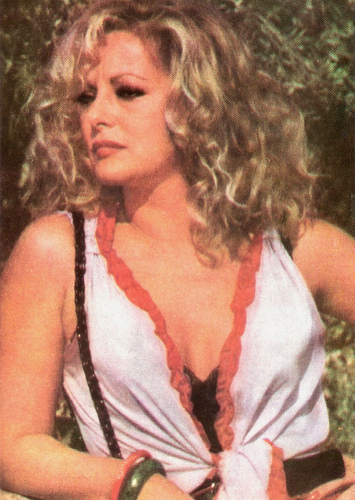
Romanian postcard by Casa Filmului Acin.
Trailer of La Reine Margot/Queen Margot (Patrice Chéreau, 1994). Source: mearbhrach (YouTube).
Sources: John Francis Lane (The Guardian), Hal Erickson (AllMovie), Robert Firsching (AllMovie), Karl Williams (AllMovie), (IMDb), Glamour Girls of the Silver Screen, Wikipedia and .

Romanian postcard by Casa Filmului Acin. Retail price: 2 Lei.

Italian postcard. Photo: Paramount. Publicity still for Assault on a Queen (Jack Donohue, 1966).
With Such A Mouth...
Virna Lisi was born as Virna Lisa Pieralisi in Ancona, Italy in 1936. Her father had a marble exporting business on the Adriatic coast. Her brother, Ubaldo Pieralisi, later became a talent agent, and her sister Esperia Pieralisi also became an actress.
Virna began her film career as a teenager. She was discovered by two Neapolitan producers, Antonio Ferrigno and Ettore Pesce, in Paris. Her debut was in La corda d'acciaio/The line of steel (Carlo Borghesio, 1953-1958).
Initially, she did musical films, like E Napoli canta/Napoli sings (Armando Grottini, 1953) and the successful four-episode film Questa è la vita/Such is life (Luigi Zampa a.o., 1954), with the popular Totò .
Her looks were more valued than her talent in some of her early films, like in Le diciottenni/Eighteen Year Olds (Mario Mattoli, 1955) with Marisa Allasio , and Lo scapolo/The Bachelor (Antonio Pietrangeli, 1955) with Alberto Sordi .
She incarnated more demanding roles in Il cardinale Lambertini/Cardinal Lambertini (Giorgio Pastina, 1954) opposite Gino Cervi , La Donna del Giorno/The Doll That Took the Town (Francesco Maselli, 1956), the peplum Romolo e Remo/Duel of the Titans (Sergio Corbucci, 1961) featuring musclemen Steve Reeves and Gordon Scott as the two legendary brothers Romulus and Remus, and Eva/Eve (Joseph Losey, 1962) starring Jeanne Moreau .
In the late 1950s, Lisi played on stage at the Piccolo Teatro di Milano, and appeared in I giacobini by Federico Zardi, under the direction of Giorgio Strehler.
During the 1960s, she performed in stage comedies and she also participated in some very popular television dramas. On TV she also promoted a toothpaste brand, with a slogan which would become a catchphrase amongst the Italians: "con quella bocca può dire ciò che vuole" (with such a mouth, she can say whatever she wants).

Italian postcard by Rotalcolor, Milano, no. 660.

East-German postcard by VEB Progress Filmvertrieb, Berlin, no. 2481, 1965. Photo: publicity still for La tulipe noire/The Black Tulip (Christian-Jacque, 1964) with Alain Delon and Virna Lisi.

East-German postcard by VEB Progress Film-Vertrieb, Berlin, no. 2869. Retail price: 0,20 MDN.
Tempting Blue-eyed Blonde
In France, Virna Lisi played the role that brought her first international attention, in La tulipe noire/The Black Tulip (Christian-Jacque, 1964). As the heroine to Alain Delon ’s dashing swashbuckler, she combined sexiness with dexterity.
In the 1960s, Hollywood producers were looking for a successor to Marilyn Monroe and so Lisi then made a dent in Hollywood comedies as a tempting blue-eyed blonde.
She first starred opposite Jack Lemmon in George Axelrod’s satirical How to Murder Your Wife (Richard Quine, 1965). At IMDb, reviewer Mdantonio takes his hat off for her performance: “What most everyone fails to mention in the comments is the incredible skill of Virna Lisi. She is a natural mixing it up with Lemmon, (Claire) Trevor and the other veterans like she had been making movies for years. I have watched many movies in my day and I must say that Virna Lisi is right at the top, not only in beauty and sexuality but in carrying her role as good as anyone else could have. Ms. Lisi, my hat is off to you.”
Lisi also gained attention with the March 1965 cover of Esquire magazine on which she was shaving her face. The following year she appeared in another comedy, Not with My Wife, You Don't! (Norman Panama, 1966) now with Tony Curtis.
She also starred with Frank Sinatra in Assault on a Queen (Jack Donohue, 1966), with Rod Steiger in La Ragazza e il Generale/The Girl and the General (Pasquale Festa Campanile, 1967), and twice with Anthony Quinn, in the war drama La vingt-cinquième heure/The 25th Hour (Henri Verneuil, 1967), and in The Secret of Santa Vittoria (Stanley Kramer, 1969).
John Francis Lane in his obituary in The Guardian : "Though she enjoyed her American experiences and appreciated the professionalism she encountered, Lisi soon tired of the 'new Marilyn' image foisted upon her. She accepted becoming a cover girl but refused a lucrative offer to pose for Playboy."
To overcome her typecasting as a sexy, seductive woman, Lisi sought new types of roles, and found these in such Italian comedies as Le bambole/Four Kinds of Love (Dino Risi a.o., 1965), Signore & signori/The Birds, the Bees and the Italians (Pietro Germi, 1966) and Le dolci signore/Anyone Can Play (Fausto Saraceni, Luigi Zampa, 1968), and Roma bene (Carlo Lizzani, 1971) with Senta Berger .
At AllMovie , Robert Firsching reviews Signore & signori: “Pietro Germi's funny anthology combines the standard sex comedy format with some unexpectedly subtle observations about village life. The film centers on three stories exposing the sexual secrets of the Italian town of Treviso. (...) Signore e Signori won the Best Film award at the 1966 Cannes Film Festival.”

Romanian postcard by Casa Filmului Acin, no. 43078.

Yugoslavian postcard by Cik Razglednica.
Career Renaissance
In the early 1970s, Virna Lisi decided to focus on her family, husband Franco Pesci and her son Corrado, born in 1962.
In the later 1970s she had a career renaissance with a series of major Italian films. She played Friedrich Nietzsche’s neurotic sister, Elisabeth, in the controversial Al di là del bene e del male/Beyond Good and Evil (Liliana Cavani, 1977) starring Dominique Sanda .
It was followed by roles in Ernesto (Salvatore Samperi, 1979), La cicala/The Cricket (Alberto Lattuada, 1980), and I ragazzi di via Panisperna/The Boys of the Via Panisperna (Gianni Amelio, 1989) with Andrea Prodan and Mario Adorf .
Andrea Prodan’s brother Luca Prodan is the singer of the Argentinean band Sumo which made a song for Lisi. The Brazilian rock band Virna Lisi is even named after her.
Her greatest triumph was the French film La Reine Margot/Queen Margot (Patrice Chéreau, 1994) in which Lisi played a malevolent Catherine de Medici, ordering assaults, poisonings, and instigations to incest.
Karl Williams writes at AllMovie : “The historical novel by Alexandre Dumas was adapted for the screen with this lavish French epic, winner of 5 Césars and a pair of awards at the Cannes Film Festival. Isabelle Adjani stars as Marguerite de Valois, better known as Margot, daughter of scheming Catholic power player Catherine de Medici (Virna Lisi).”
For her magnificent portrayal Lisi won the César and the Best Actress award in Cannes, and also the David di Donatello award, the Italian equivalent of the Oscar.
Since the late 1990s, she did many successful dramatic TV productions, including L'onore e il rispetto/Honour and respect (Salvatore Samperi, 2006) with Gabriel Garko and Giancarlo Giannini.
In 2002, Lisi starred in Il più bel giorno della mia vita/The Best Day of My Life (Cristina Comencini, 2002) with Margherita Buy, and she reunited with director Cristina Comencini for her final film, the comedy Latin Lover, which will be released next year.
Since 1960, Virna Lisi was married to architect Franco Pesci, who died last year. She is survived by her son Corrado and three grandchildren: Franco, Federico and Riccardo.

Romanian postcard by Casa Filmului Acin. Collection: Veronique3@Flickr.

Romanian postcard by Casa Filmului Acin.
Trailer of La Reine Margot/Queen Margot (Patrice Chéreau, 1994). Source: mearbhrach (YouTube).
Sources: John Francis Lane (The Guardian), Hal Erickson (AllMovie), Robert Firsching (AllMovie), Karl Williams (AllMovie), (IMDb), Glamour Girls of the Silver Screen, Wikipedia and .
Published on December 18, 2014 15:00
December 17, 2014
Ina Bauer (1941-2014)
On 13 December, German competitive figure skater Ina Bauer (1941-2014) died. She won three consecutive West German national titles, in 1957, 1958 and 1959. 'Brigitte Bardot on ice' also starred in two films with Austrian alpine skier Toni Sailer.
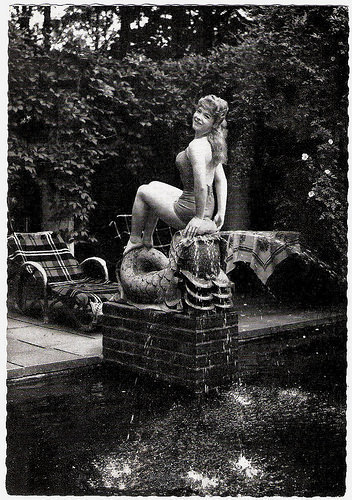
German postcard by Starpostkarten-Vertrieb Ernst Freihoff, Essen, no. 701. Photo: Lothar Winkler.
The Ina Bauer move
Born in 1941 in Krefeld, Germany, in the midst of World War II, Ina Bauer made her first appearance on the senior level at the 1956 West German Figure Skating Championships in Cologne, where she finished second.
In the following years, she won three consecutive West German national titles, in 1957, 1958 and 1959. She competed at a total of four European and World Championships, improving her results very quickly along the way.
She invented the skating move which bears her name. The Ina Bauer is a variation on the spread eagle where one leg is bent deeply at the knee, the back and body bend backwards and the other leg traces a parallel line on a back inside edge.

German postcard by Starpostkarten-Vertrieb Ernst Freihoff, Essen, no. 703. Photo: Lothar Winkler.
Brigitte Bardot on ice
After withdrawing from the 1960 European Championships in Garmisch-Partenkirchen, Ina Bauer retired from competition at her father's request.
She then toured with Ice Follies and starred in two films with Austrian alpine skier Toni Sailer : the comedy Ein Stern fällt vom Himmel/A Star Falls from Heaven (Géza von Cziffra, 1961) and Kauf dir einen bunten Luftballon/Buy yourself a colourful balloon (Géza von Cziffra, 1961).
With her flaming red hair, she made as pretty picture and The New York Times wrote of Bauer's American debut in Ice Follies: "19-year-old Ina Bauer, three-time figure skating champion of West Germany has been called 'Brigitte Bardot on ice' and it's easy to see why."
She married Hungarian figure skater István Szenes. Ina Szenes-Bauer was 73.
Sources: Ryan Stevens (Skate Guard), Wikipedia and .

German postcard by Starpostkarten-Vertrieb Ernst Freihoff, Essen, no. 701. Photo: Lothar Winkler.
The Ina Bauer move
Born in 1941 in Krefeld, Germany, in the midst of World War II, Ina Bauer made her first appearance on the senior level at the 1956 West German Figure Skating Championships in Cologne, where she finished second.
In the following years, she won three consecutive West German national titles, in 1957, 1958 and 1959. She competed at a total of four European and World Championships, improving her results very quickly along the way.
She invented the skating move which bears her name. The Ina Bauer is a variation on the spread eagle where one leg is bent deeply at the knee, the back and body bend backwards and the other leg traces a parallel line on a back inside edge.

German postcard by Starpostkarten-Vertrieb Ernst Freihoff, Essen, no. 703. Photo: Lothar Winkler.
Brigitte Bardot on ice
After withdrawing from the 1960 European Championships in Garmisch-Partenkirchen, Ina Bauer retired from competition at her father's request.
She then toured with Ice Follies and starred in two films with Austrian alpine skier Toni Sailer : the comedy Ein Stern fällt vom Himmel/A Star Falls from Heaven (Géza von Cziffra, 1961) and Kauf dir einen bunten Luftballon/Buy yourself a colourful balloon (Géza von Cziffra, 1961).
With her flaming red hair, she made as pretty picture and The New York Times wrote of Bauer's American debut in Ice Follies: "19-year-old Ina Bauer, three-time figure skating champion of West Germany has been called 'Brigitte Bardot on ice' and it's easy to see why."
She married Hungarian figure skater István Szenes. Ina Szenes-Bauer was 73.
Sources: Ryan Stevens (Skate Guard), Wikipedia and .
Published on December 17, 2014 22:00
December 16, 2014
Lambert Wilson
Talented and lanky but handsome French actor Lambert Wilson (1958) worked with many of Europes most prestigious auteur directors, including Alain Resnais, Luigi Comencini, Claude Chabrol, Peter Greenaway and James Ivory. He also appeared in several Hollywood blockbusters.
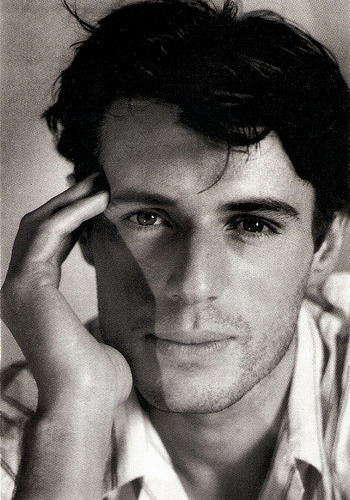
French postcard, no. CP 101.
Touch of genius
Lambert Wilson was born in Neuilly-sur-Seine in Paris, France, in 1958. He is half Irish, half French. His mother Nicole is a former French model. His father is actor-director Georges Wilson and Lambert speaks English fluently.
As a child, his father used to tell the journalists that he lived alone. He was a married family father, who wanted to protect his family from the paparazzi. So Lambert and his brother grew up tranquilly.
He studied acting at the Drama Centre in London, but in 1977, he left before completing the course to make his professional stage debut in Paris in a play with his father. He made his feature film debut in a small part in Fred Zinnemann’s Julia (1977) with Jane Fonda and Vanessa Redgrave .
He returned in Zinnemann's last film, Five Days One Summer (Fred Zinnemann, 1981), in a lead role opposite Sean Connery . It is the story of an illicit romance, set in the Swiss Alps. Less successful was the Brooke Shields vehicle Sahara (Andrew V. McLaglen, 1983). It was a massive box office bomb, and at the 1984 Razzies, Shields was nominated for Worst Actress and won Worst Supporting Actor as ‘Brooke Shields (with a moustache)’.
Wilson also worked in the French cinema, playing leads in Le sang des autres/Blood of Others (Claude Chabrol, 1984) opposite Jodie Forster, La Femme Publique/The Public Woman (Andrzej Zulawski, 1983), and Rendez-vous (André Téchiné, 1984) with Juliette Binoche. The latter was chosen for the official selection at the 1984 Cannes Film Festival, where it won the Best Director Award.
Then followed roles in international films like La Storia/History (Luigi Comencini, 1985) with Claudia Cardinale , and Peter Greenaway's The Belly of an Architect (1987) featuring Brian Dennehy.
Wilson screen tested for The Living Daylights (John Glen, 1987) for the role of James Bond. He appeared in test footage opposite Maryam d'Abo (the Bond girl in The Living Daylights) as Tatiana Romanova, re-enacting scenes from From Russia with Love (Terence Young, 1963). Timothy Dalton finally played 007.
Wilson starred in his father’s feature film debut, La Vouivre/The Sorceress (Georges Wilson, 1988), and won the Jean Gabin Award for his performance as the legendary priest Abbé Pierre in Hiver 54, l'abbé Pierre/Winter '54 (Denis Amar, 1989).
James Travers at French Film Site : “The casting of Lambert Wilson as Abbé Pierre is the latter film's one touch of genius, and Wilson repays the honour by turning in one of the most respectable performances of his career (one that earned him his third César nomination). Wilson, unlike the director, instinctively knew how to pitch the film and portrays Abbé Pierre not as a beatified superhero but as an ordinary man of the people, driven by an extraordinary compassion for his fellow man.”
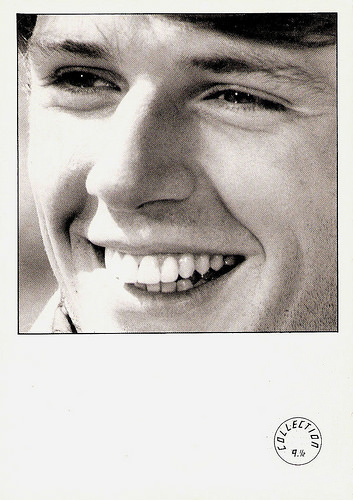
French postcard by Editions Humour à la carte, Paris, no. ST-69.

French postcard, no. 199.
The villainous Merovingian
During the 1990s, Lambert Wilson smoothly continued his international career. In 1991. he was featured in a series of Calvin Klein ads featuring Christy Turlington.
He starred opposite Hanna Schygulla in Warszawa. Année 5703/Warsaw: Year 5703 (Janusz Kijowski, 1992) about the horrors in the Jewish ghetto in Warsaw 1943. In Jefferson in Paris (James Ivory, 1994), he appeared opposite Nick Nolte and Gwyneth Paltrow.
In the less interesting The Leading Man (John Duigan, 1996), he co-starred with Thandie Newton and John Bon Jovi. He performs on stage in both French and English, and in 1996, he co-starred with Judi Dench in the musical A Little Night Music for the Royal National Theater in London
He made four films with director Alain Resnais: On connaît la chanson/Same Old Song (1997), Pas sur la Bouche/Not on the Lips (2003), Coeurs/Private Fears in Public Places (2006) and Vous n'avez encore rien vu/You Ain't Seen Nothing Yet (2012).
Other films are Trop (peu) d'amour/Too Much (Little) Love (Jacques Doillon, 1997) with Lou Doillon, and The Last September (Deborah Warner, 1998), with Maggie Smith. He also starred in Raùl Ruiz's Combat d'amour en songe/Love Torn in a Dream (2000) with Melvil Poupaud.
In addition to his acting career, Wilson narrated classical works under the direction of some of the world's most notable conductors, and released a pair of albums featuring both classic songs from American musicals and the golden age of French cinema.
Wilson’s best known role is probably the villainous Merovingian in the Hollywood blockbusters Matrix Reloaded (The Wachowski Brothers, 2003) and Matrix Revolutions (The Wachowski Brothers, 2003), the second and third instalments in The Matrix trilogy.
He appeared in more American productions, including, Catwoman (Pitof, 2004) with Halle Berry and Sharon Stone, Sahara (Breck Eisner, 2005) starring Matthew McConaughey and Penelope Cruz, Flawless (Michael Radford, 2006) with Demi Moore and Michael Caine, and Babylon A.D. (Mathieu Kassovitz, 2007) with Vin Diesel and Charlotte Rampling .
In 2009, he played in Xavier Beauvois' Des Hommes et des Dieux/Of Gods and Men (2009), which was presented in Cannes, where it won the Grand Prize of the Jury.
Mark Deming at AllMovie : “Of Gods and Men was inspired by the true story of eight French monks kidnapped by Algerian terrorists in 1996, and while Beauvois builds a credible amount of suspense, after a certain point the fate of the brothers seems inevitable; what makes this story compelling is how the men react to their circumstances -- some with fear, some with grim resignation, many with the simple but firm belief that it is their duty to serve and obey their call and that all else is of minimal importance. While Lambert Wilson as Christian, the group's leader (he generally seems more like the first among equals), and Michael Lonsdale as Luc, the aging and sweetly gruff doctor of the group, stand out in the cast, this is very much an ensemble piece, with each of the eight monks playing a vital role, and the cast and Beauvois have made that rare film about faith that takes the rituals of worship seriously.”
In France, Wilson also appeared in films like Palais Royal! (Valérie Lemercier, 2004), the costume drama La princesse de Montpensier/The Princess of Montpensier (Bertrand Tavernier, 2009) featuring Mélanie Thierry, the CGI-animated/live-action family comedy Sur la Piste du Marsupilami/Le Marsupilami (Alain Chabat, 2011) with Jamel Debbouze, and the comedy Alceste à bicyclette/Cycling with Moliere (Philippe Le Guay, 2012).
In the summer of 2013, he played the lead in Barbecue (Eric Lavaine, 2014) opposite Florence Foresti and Franck Dubosc. Recently, he starred in three international productions, Posthumous (Lulu Wang, 2014), 5 to 7 (Victor Levin, 2014), and Suite Française (2014), opposite Michelle Williams, Kristin Scott Thomas and Matthias Shoenaerts.
Lambert Wilson is a Chevalier and Officier des Arts et des Lettres and Chevalier and Officier de l'Ordre National du Merite.

French postcard, no. C 89.
Wilson doing Celine Dion in a hilarious clip from Sur la Piste du Marsupilami/Le Marsupilami (Alain Chabat, 2011). Source: FitchEye (YouTube).
Sources: (IMDb), James Travers (French Film Site), Jason Buchanan (AllMovie), Mark Deming (AlMovie), Wikipedia, and .

French postcard, no. CP 101.
Touch of genius
Lambert Wilson was born in Neuilly-sur-Seine in Paris, France, in 1958. He is half Irish, half French. His mother Nicole is a former French model. His father is actor-director Georges Wilson and Lambert speaks English fluently.
As a child, his father used to tell the journalists that he lived alone. He was a married family father, who wanted to protect his family from the paparazzi. So Lambert and his brother grew up tranquilly.
He studied acting at the Drama Centre in London, but in 1977, he left before completing the course to make his professional stage debut in Paris in a play with his father. He made his feature film debut in a small part in Fred Zinnemann’s Julia (1977) with Jane Fonda and Vanessa Redgrave .
He returned in Zinnemann's last film, Five Days One Summer (Fred Zinnemann, 1981), in a lead role opposite Sean Connery . It is the story of an illicit romance, set in the Swiss Alps. Less successful was the Brooke Shields vehicle Sahara (Andrew V. McLaglen, 1983). It was a massive box office bomb, and at the 1984 Razzies, Shields was nominated for Worst Actress and won Worst Supporting Actor as ‘Brooke Shields (with a moustache)’.
Wilson also worked in the French cinema, playing leads in Le sang des autres/Blood of Others (Claude Chabrol, 1984) opposite Jodie Forster, La Femme Publique/The Public Woman (Andrzej Zulawski, 1983), and Rendez-vous (André Téchiné, 1984) with Juliette Binoche. The latter was chosen for the official selection at the 1984 Cannes Film Festival, where it won the Best Director Award.
Then followed roles in international films like La Storia/History (Luigi Comencini, 1985) with Claudia Cardinale , and Peter Greenaway's The Belly of an Architect (1987) featuring Brian Dennehy.
Wilson screen tested for The Living Daylights (John Glen, 1987) for the role of James Bond. He appeared in test footage opposite Maryam d'Abo (the Bond girl in The Living Daylights) as Tatiana Romanova, re-enacting scenes from From Russia with Love (Terence Young, 1963). Timothy Dalton finally played 007.
Wilson starred in his father’s feature film debut, La Vouivre/The Sorceress (Georges Wilson, 1988), and won the Jean Gabin Award for his performance as the legendary priest Abbé Pierre in Hiver 54, l'abbé Pierre/Winter '54 (Denis Amar, 1989).
James Travers at French Film Site : “The casting of Lambert Wilson as Abbé Pierre is the latter film's one touch of genius, and Wilson repays the honour by turning in one of the most respectable performances of his career (one that earned him his third César nomination). Wilson, unlike the director, instinctively knew how to pitch the film and portrays Abbé Pierre not as a beatified superhero but as an ordinary man of the people, driven by an extraordinary compassion for his fellow man.”

French postcard by Editions Humour à la carte, Paris, no. ST-69.

French postcard, no. 199.
The villainous Merovingian
During the 1990s, Lambert Wilson smoothly continued his international career. In 1991. he was featured in a series of Calvin Klein ads featuring Christy Turlington.
He starred opposite Hanna Schygulla in Warszawa. Année 5703/Warsaw: Year 5703 (Janusz Kijowski, 1992) about the horrors in the Jewish ghetto in Warsaw 1943. In Jefferson in Paris (James Ivory, 1994), he appeared opposite Nick Nolte and Gwyneth Paltrow.
In the less interesting The Leading Man (John Duigan, 1996), he co-starred with Thandie Newton and John Bon Jovi. He performs on stage in both French and English, and in 1996, he co-starred with Judi Dench in the musical A Little Night Music for the Royal National Theater in London
He made four films with director Alain Resnais: On connaît la chanson/Same Old Song (1997), Pas sur la Bouche/Not on the Lips (2003), Coeurs/Private Fears in Public Places (2006) and Vous n'avez encore rien vu/You Ain't Seen Nothing Yet (2012).
Other films are Trop (peu) d'amour/Too Much (Little) Love (Jacques Doillon, 1997) with Lou Doillon, and The Last September (Deborah Warner, 1998), with Maggie Smith. He also starred in Raùl Ruiz's Combat d'amour en songe/Love Torn in a Dream (2000) with Melvil Poupaud.
In addition to his acting career, Wilson narrated classical works under the direction of some of the world's most notable conductors, and released a pair of albums featuring both classic songs from American musicals and the golden age of French cinema.
Wilson’s best known role is probably the villainous Merovingian in the Hollywood blockbusters Matrix Reloaded (The Wachowski Brothers, 2003) and Matrix Revolutions (The Wachowski Brothers, 2003), the second and third instalments in The Matrix trilogy.
He appeared in more American productions, including, Catwoman (Pitof, 2004) with Halle Berry and Sharon Stone, Sahara (Breck Eisner, 2005) starring Matthew McConaughey and Penelope Cruz, Flawless (Michael Radford, 2006) with Demi Moore and Michael Caine, and Babylon A.D. (Mathieu Kassovitz, 2007) with Vin Diesel and Charlotte Rampling .
In 2009, he played in Xavier Beauvois' Des Hommes et des Dieux/Of Gods and Men (2009), which was presented in Cannes, where it won the Grand Prize of the Jury.
Mark Deming at AllMovie : “Of Gods and Men was inspired by the true story of eight French monks kidnapped by Algerian terrorists in 1996, and while Beauvois builds a credible amount of suspense, after a certain point the fate of the brothers seems inevitable; what makes this story compelling is how the men react to their circumstances -- some with fear, some with grim resignation, many with the simple but firm belief that it is their duty to serve and obey their call and that all else is of minimal importance. While Lambert Wilson as Christian, the group's leader (he generally seems more like the first among equals), and Michael Lonsdale as Luc, the aging and sweetly gruff doctor of the group, stand out in the cast, this is very much an ensemble piece, with each of the eight monks playing a vital role, and the cast and Beauvois have made that rare film about faith that takes the rituals of worship seriously.”
In France, Wilson also appeared in films like Palais Royal! (Valérie Lemercier, 2004), the costume drama La princesse de Montpensier/The Princess of Montpensier (Bertrand Tavernier, 2009) featuring Mélanie Thierry, the CGI-animated/live-action family comedy Sur la Piste du Marsupilami/Le Marsupilami (Alain Chabat, 2011) with Jamel Debbouze, and the comedy Alceste à bicyclette/Cycling with Moliere (Philippe Le Guay, 2012).
In the summer of 2013, he played the lead in Barbecue (Eric Lavaine, 2014) opposite Florence Foresti and Franck Dubosc. Recently, he starred in three international productions, Posthumous (Lulu Wang, 2014), 5 to 7 (Victor Levin, 2014), and Suite Française (2014), opposite Michelle Williams, Kristin Scott Thomas and Matthias Shoenaerts.
Lambert Wilson is a Chevalier and Officier des Arts et des Lettres and Chevalier and Officier de l'Ordre National du Merite.

French postcard, no. C 89.
Wilson doing Celine Dion in a hilarious clip from Sur la Piste du Marsupilami/Le Marsupilami (Alain Chabat, 2011). Source: FitchEye (YouTube).
Sources: (IMDb), James Travers (French Film Site), Jason Buchanan (AllMovie), Mark Deming (AlMovie), Wikipedia, and .
Published on December 16, 2014 22:00
December 15, 2014
Suzy Carrier
French actress Suzy Carrier (1922-1999) was a pretty ingénue who appeared in several comedies and crime dramas of the 1940s and early 1950s.
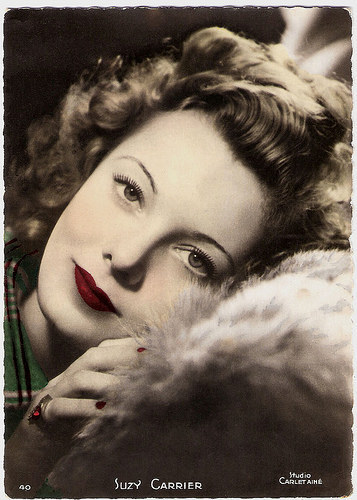
French postcard by Editions P.I., Paris, no. 40. Photo: Carlet Ainé.
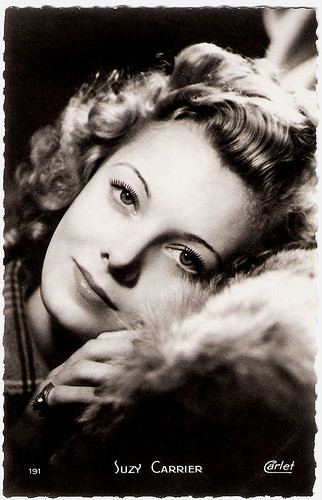
French postcard by Editions P.I., Paris, no. 191. Photo: Carlet.
A piece of resistance
Suzy Carrier was born as Suzanne Knubel in Moulins, France in 1922. She spent her youth between two beloved women, her aunt and grandmother, while her parents lived in Paris.
After finishing her education, she moved to her family to Paris. Another aunt, Eliane Carrier of the Opera detected the artist's temperament in her niece.
Suzy studied drama at the Conservatoire and made her film debut during the German occupation of France. She played next to Pierre Blanchar and Annie Ducaux in Pontcarral, colonel d'Empire/ Pontcarral - colonel of the empire (Jean Delannoy, 1942), based on a novel by Albéric Cahuet. Some critics viewed the film as a piece of resistance against the Nazis.
D.B. DuMonteil at IMDb : “Some directors did not want to give up struggling in an occupied France. So they used the Middle Ages (Les Visiteurs Du Soir) or the Restoration (this movie) to tell their compatriots they had to carry on the fight. They say the audience used to applause during the last scenes, when the colonel was reinstated in his French army and was leaving for Algeria. After two hours of resistance against the new kings, Louis the Eighteenth and Charles the Tenth, Louis-Philippe told him he needed men of his value.” Several lines were cut by the German censorship.
Next her co-star Pierre Blanchar directed her in Secrets (1943), an adaptation of the play A Month in the Country by Ivan Turgenev. The lead roles were played by Pierre Blanchar , Marie Déa and Jacques Dumesnil . During the shooting, Carrier nearly drowned.
D.B. DuMonteil at IMDb : “ Pierre Blanchar , an actor who directed only two films, manages quite well. Arthur Honegger's splendid score and Matras's quivering cinematography help. So does the cast. There's a long dreamlike sequence which throws the movie a bit off balance, because it verges on tongue in cheek while the rest of the story is solid psychological drama. (...) Although filmed during the German occupation, ‘Secrets’ seems to happen in a different age. Hence its charm.”
Other films in which she appeared during the war years were L'Escalier sans fin/The endless stairs (Georges Lacombe, 1943) with Pierre Fresnay , and L'aventure est au coin de la rue/The adventure is around the corner (Jacques Daniel-Norman, 1944) starring Raymond Rouleau.
After the war she continued her films career opposite Bourvil in the comedy Pas si bête/Not so stupid (André Berthomieu, 1946) and opposite Armand Bernard in another comedy, Bichon (René Jayet, 1947).
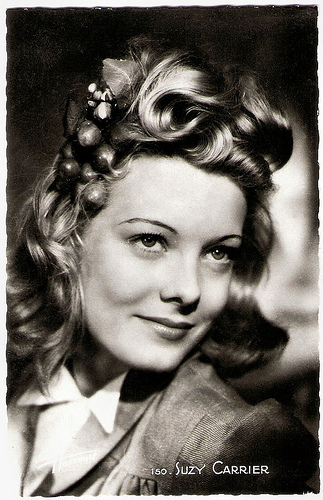
French postcard by SERP, Paris, no. 150. Photo: Studio Harcourt.
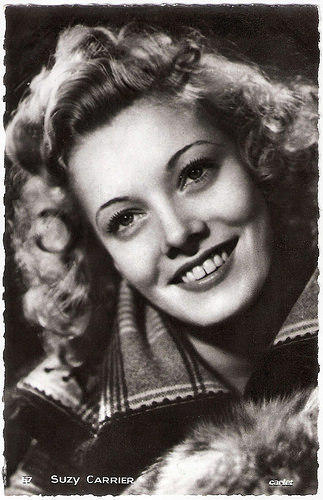
French postcard, no. 67. Photo: Carlet.
The cow Yolande
During the early 1950s, Suzy Carrier continued to play leading roles in comedies. In Les Mémoires de la vache Yolande/The memories of the cow Yolande (Ernst Neubach, 1950, she was the love interest of Rellys , and in Le Père de Mademoiselle/The Father of the Girl (Marcel L'Herbier, 1953) she was the daughter of André Luguet .
In 1955 she played Madame Elisabeth in the lush historical drama Marie-Antoinette reine de France/Marie Antoinette Queen of France (Jean Delannoy, 1955) starring Michèle Morgan as the Queen and Richard Todd as her lover, Count Axel von Fersen.
After that, Carrier’s film career had an intermission of nearly 20 years. Then she returned to the screen in a small part in the comedy Na! (Jacques Martin, 1973). She also appeared in the West German-French co-production Die Antwort kennt nur der Wind/Only the Wind Knows the Answer (Alfred Vohrer, 1974). Maurice Ronet portrays in this routine thriller an insurance agent who investigates a millionaire’s suicide (or was it one?) and his life insurance. It was Carrier’s final film.
Suzy Carrier died in Grasse in the French Alps in 1999. She was 77. She was married twice. Her first marriage, to Dr. George Loublié was announced in 1943. Her second husband was M. Schmitt, a banker in Le Vésinet, France.
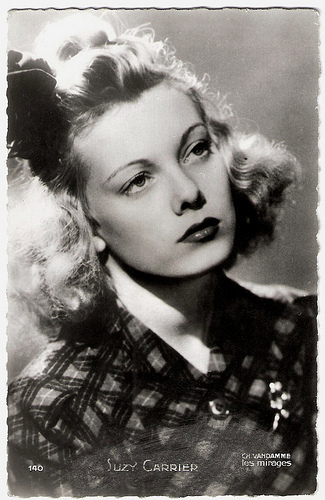
French postcard by Editions P.I., Paris, no. 140. Photo: Ch. Vandamme / Les Mirages.
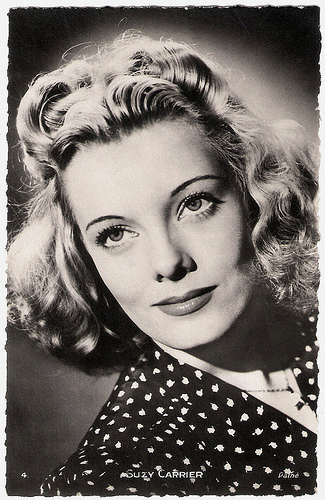
French postcard by Editions E.C., Paris, no. 4. Photo: Pathé.
Sources: Louis Delallier (Le grenier de mon moulins - French), D.B. DuMonteil (IMDb), Wikipedia (French) and .

French postcard by Editions P.I., Paris, no. 40. Photo: Carlet Ainé.

French postcard by Editions P.I., Paris, no. 191. Photo: Carlet.
A piece of resistance
Suzy Carrier was born as Suzanne Knubel in Moulins, France in 1922. She spent her youth between two beloved women, her aunt and grandmother, while her parents lived in Paris.
After finishing her education, she moved to her family to Paris. Another aunt, Eliane Carrier of the Opera detected the artist's temperament in her niece.
Suzy studied drama at the Conservatoire and made her film debut during the German occupation of France. She played next to Pierre Blanchar and Annie Ducaux in Pontcarral, colonel d'Empire/ Pontcarral - colonel of the empire (Jean Delannoy, 1942), based on a novel by Albéric Cahuet. Some critics viewed the film as a piece of resistance against the Nazis.
D.B. DuMonteil at IMDb : “Some directors did not want to give up struggling in an occupied France. So they used the Middle Ages (Les Visiteurs Du Soir) or the Restoration (this movie) to tell their compatriots they had to carry on the fight. They say the audience used to applause during the last scenes, when the colonel was reinstated in his French army and was leaving for Algeria. After two hours of resistance against the new kings, Louis the Eighteenth and Charles the Tenth, Louis-Philippe told him he needed men of his value.” Several lines were cut by the German censorship.
Next her co-star Pierre Blanchar directed her in Secrets (1943), an adaptation of the play A Month in the Country by Ivan Turgenev. The lead roles were played by Pierre Blanchar , Marie Déa and Jacques Dumesnil . During the shooting, Carrier nearly drowned.
D.B. DuMonteil at IMDb : “ Pierre Blanchar , an actor who directed only two films, manages quite well. Arthur Honegger's splendid score and Matras's quivering cinematography help. So does the cast. There's a long dreamlike sequence which throws the movie a bit off balance, because it verges on tongue in cheek while the rest of the story is solid psychological drama. (...) Although filmed during the German occupation, ‘Secrets’ seems to happen in a different age. Hence its charm.”
Other films in which she appeared during the war years were L'Escalier sans fin/The endless stairs (Georges Lacombe, 1943) with Pierre Fresnay , and L'aventure est au coin de la rue/The adventure is around the corner (Jacques Daniel-Norman, 1944) starring Raymond Rouleau.
After the war she continued her films career opposite Bourvil in the comedy Pas si bête/Not so stupid (André Berthomieu, 1946) and opposite Armand Bernard in another comedy, Bichon (René Jayet, 1947).

French postcard by SERP, Paris, no. 150. Photo: Studio Harcourt.

French postcard, no. 67. Photo: Carlet.
The cow Yolande
During the early 1950s, Suzy Carrier continued to play leading roles in comedies. In Les Mémoires de la vache Yolande/The memories of the cow Yolande (Ernst Neubach, 1950, she was the love interest of Rellys , and in Le Père de Mademoiselle/The Father of the Girl (Marcel L'Herbier, 1953) she was the daughter of André Luguet .
In 1955 she played Madame Elisabeth in the lush historical drama Marie-Antoinette reine de France/Marie Antoinette Queen of France (Jean Delannoy, 1955) starring Michèle Morgan as the Queen and Richard Todd as her lover, Count Axel von Fersen.
After that, Carrier’s film career had an intermission of nearly 20 years. Then she returned to the screen in a small part in the comedy Na! (Jacques Martin, 1973). She also appeared in the West German-French co-production Die Antwort kennt nur der Wind/Only the Wind Knows the Answer (Alfred Vohrer, 1974). Maurice Ronet portrays in this routine thriller an insurance agent who investigates a millionaire’s suicide (or was it one?) and his life insurance. It was Carrier’s final film.
Suzy Carrier died in Grasse in the French Alps in 1999. She was 77. She was married twice. Her first marriage, to Dr. George Loublié was announced in 1943. Her second husband was M. Schmitt, a banker in Le Vésinet, France.

French postcard by Editions P.I., Paris, no. 140. Photo: Ch. Vandamme / Les Mirages.

French postcard by Editions E.C., Paris, no. 4. Photo: Pathé.
Sources: Louis Delallier (Le grenier de mon moulins - French), D.B. DuMonteil (IMDb), Wikipedia (French) and .
Published on December 15, 2014 22:00
December 14, 2014
André Roanne
André Roanne (1896-1959) had a long standing career in French cinema of more than 90 films. He started as a kid actor in short silent films in 1914, and ended with the part of the commissioner in Henri Verneuil's Une manche et la belle/A Kiss for a Killer (1957).
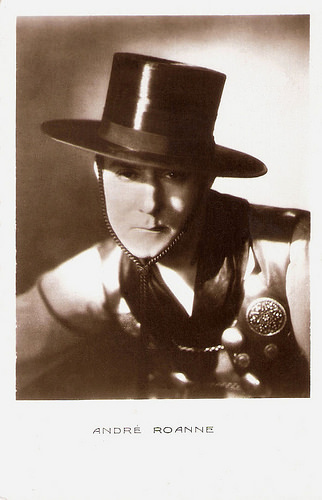
Vintage postcard. Photo: publicity still for the early sound film Accusée levez-vous/Accused, Stand Up (Maurice Tourneur, 1930).
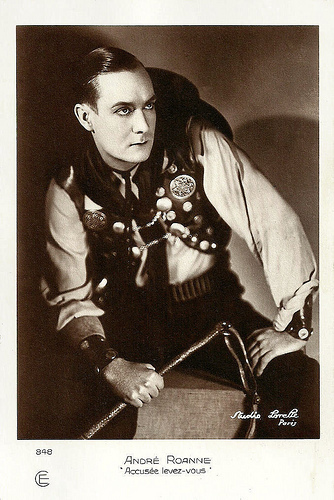
French postcard by CE (Cinémagazine-Edition), no. 848. Photo: Studio Lorelle, Paris. Publicity still for the early sound film Accusée levez-vous/Accused, Stand Up (Maurice Tourneur, 1930).
Big Moustache
André Roanne was born André Albert Louis Rahou in Paris in 1896. He made his film debut as a kid in the short and silent Gaumont production Le films de la divette/The Son of La Divette (Gaston Ravel, 1914).
After various other Gaumont shorts by Gaston Ravel during the First World War, Roanne came to the footlight in the crime serial parody Le pied qui étreint (Jacques Feyder, 1916) opposite Musidora , even if he wore a big moustache.
After more serious Gaumont productions, Roanne had a major part as Segheir ben Cheikh in Jacques Feyder's lengthy oriental drama L'Atlantide/Missing Husbands (Jacques Feyder, 1921), partly shot on location in the Sahara, and recently restored in its original colourful tinting. The leads though were for Jean Angelo as captain Morhange and Stacia Napierkowska as the cruel queen Antinea.
In those years Roanne often played the jeune premier, both in dramas such as in Violettes impériales/Imperial Violets (Henry Roussel, 1924), and comedies such as in Chouchou poids plume/Chouchou Featherweight (Gaston Ravel, 1925), which was one of Roanne's first leads.
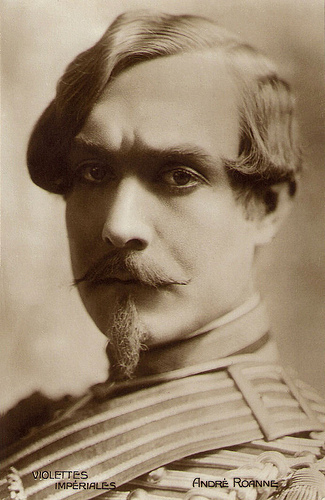
French postcard by Cinémagazine-Edition. Photo: publicity still for Violettes impériales/Imperial Violets (1924).
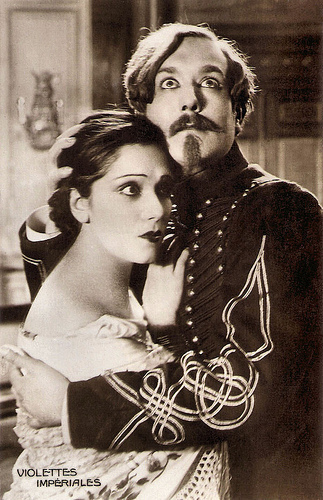
French postcard by Cinémagazine-Edition. Photo: publicity still for Violettes impériales/Imperial Violets (1924) with Raquel Meller .
Abroad
In the mid-1920s André Roanne played more and more in international coproductions, shot either in France or abroad. Opposite British silent star Betty Balfour he appeared in La petite bonne du palace/The Little Maid of the Palace (1926) and Cinders (1926), both by Louis Mercanton.
He starred opposite Mady Christians in the Austrian production Die Köningin von Moulin Rouge/The Queen of Moulin Rouge (Robert Wiene, 1926), opposite Liane Haid in the German production Der goldene Abgrund/The Golden Abyss (Mario Bonnard, 1927), and opposite Carmen Boni in Augusto Genina's La storia di una piccola Parigina/The History of a Little Parisian Girl (1928).
In the late 1920s Roanne was often matched with comédienne Dolly Davis as in La merveilleuse journée/The Wonderful Day (René Barberis, 1928).
In Berlin he played opposite Anny Ondra in Sündig und süss/Sinful and Sweet (Carl Lamac, 1929) and Die Kaviarprinzessin/\The caviar Princess (Carl Lamac, 1930), and opposite Louise Brooks in Tagebuch einer Verlorene/Diary of a Lost Girl (1929) by Georg Wilhelm Pabst.
His last silent film was Quand nous étions deux/When We Were Two (Léonce Perret, 1930).
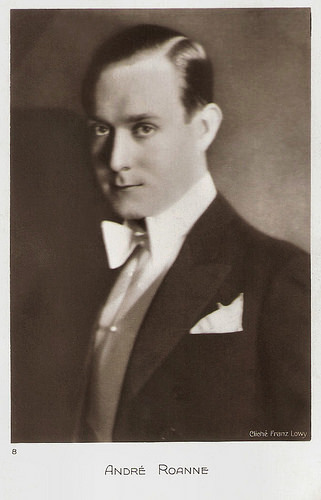
French postcard by Cinémagazine-Edition, no. 8. Photo: Franz Lowy.
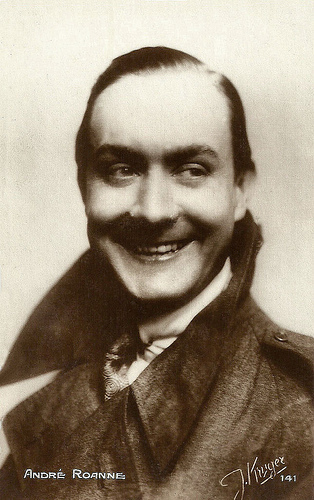
French postcard, no. 141. Photo: J. Kruger.
Fernandel
André Roanne made a smooth passage to sound film, acting in films made at the new sound studios of Paramount at Joinville such as La lettre/The Letter (Louis Mercanton, 1930) and other companies.
The international element remained with the Franco-German comedy Ma cousine de Varsovie/My cousin of Warsaw (Carmine Gallone, 1931), Calais-Douvres (Jean Boyer, Anatole Litvak, 1931) opposite Lilian Harvey , Ne sois pas jalouse/Don't Be Jealous (Augusto Genina, 1931), and Le triangle de feu/The Triangle of Fire (Edmond T. Gréville, Johannes Guter, 1932).
He also collaborated again with Dolly Davis in La chanson des nations/The Song of Nations (Maurice Gleize, Rudolf Meinert, 1931).
During the 1930s Roanne played in many average dramas and comedies, of which most titles are forgotten now; often performing opposite Dolly Davis but also with Fernandel , a.o. in Les cinq sous de Lavarède/The Five Cents of Lavarede (Maurice Cammade, 1939).
During the war years Roanne did not play in films. After an isolated part in Macadam (Jacques Feyder, 1946), he had major parts again in the 1950s in comedies starring Fernandel , in addition to smaller parts in other films.
His last role was a Commissioner in the crime film Une manche et la belle/A Kiss for a Killer (Henri Verneuil, 1957), starring Henri Vidal and Mylène Demongeot .
André Roanne died in 1959 in Cannes, France.
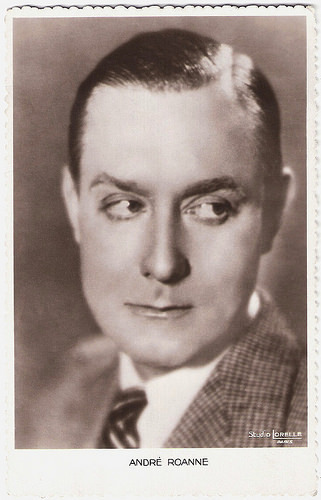
French postcard. Photo: Studio Lorelle, Paris.
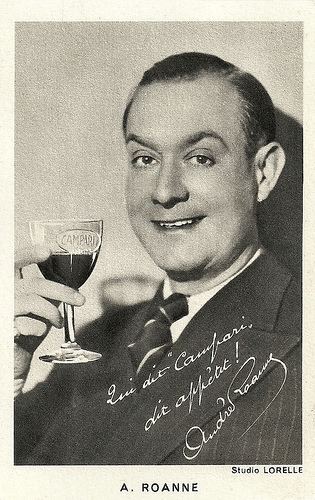
French postcard. Photo: Studio Lorelle. Caption: "Qui dit Campari, dit appétit!"
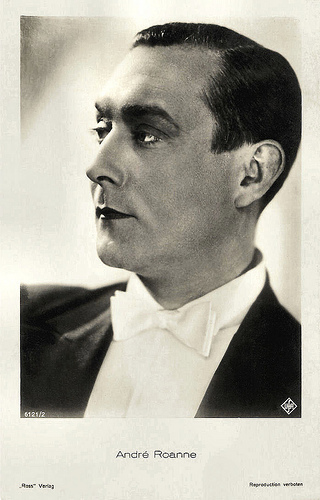
German postcard by Ross Verlag, no. 6121/2, 1931-1932. Photo: Ufa.
Sources: Wikipedia and .

Vintage postcard. Photo: publicity still for the early sound film Accusée levez-vous/Accused, Stand Up (Maurice Tourneur, 1930).

French postcard by CE (Cinémagazine-Edition), no. 848. Photo: Studio Lorelle, Paris. Publicity still for the early sound film Accusée levez-vous/Accused, Stand Up (Maurice Tourneur, 1930).
Big Moustache
André Roanne was born André Albert Louis Rahou in Paris in 1896. He made his film debut as a kid in the short and silent Gaumont production Le films de la divette/The Son of La Divette (Gaston Ravel, 1914).
After various other Gaumont shorts by Gaston Ravel during the First World War, Roanne came to the footlight in the crime serial parody Le pied qui étreint (Jacques Feyder, 1916) opposite Musidora , even if he wore a big moustache.
After more serious Gaumont productions, Roanne had a major part as Segheir ben Cheikh in Jacques Feyder's lengthy oriental drama L'Atlantide/Missing Husbands (Jacques Feyder, 1921), partly shot on location in the Sahara, and recently restored in its original colourful tinting. The leads though were for Jean Angelo as captain Morhange and Stacia Napierkowska as the cruel queen Antinea.
In those years Roanne often played the jeune premier, both in dramas such as in Violettes impériales/Imperial Violets (Henry Roussel, 1924), and comedies such as in Chouchou poids plume/Chouchou Featherweight (Gaston Ravel, 1925), which was one of Roanne's first leads.

French postcard by Cinémagazine-Edition. Photo: publicity still for Violettes impériales/Imperial Violets (1924).

French postcard by Cinémagazine-Edition. Photo: publicity still for Violettes impériales/Imperial Violets (1924) with Raquel Meller .
Abroad
In the mid-1920s André Roanne played more and more in international coproductions, shot either in France or abroad. Opposite British silent star Betty Balfour he appeared in La petite bonne du palace/The Little Maid of the Palace (1926) and Cinders (1926), both by Louis Mercanton.
He starred opposite Mady Christians in the Austrian production Die Köningin von Moulin Rouge/The Queen of Moulin Rouge (Robert Wiene, 1926), opposite Liane Haid in the German production Der goldene Abgrund/The Golden Abyss (Mario Bonnard, 1927), and opposite Carmen Boni in Augusto Genina's La storia di una piccola Parigina/The History of a Little Parisian Girl (1928).
In the late 1920s Roanne was often matched with comédienne Dolly Davis as in La merveilleuse journée/The Wonderful Day (René Barberis, 1928).
In Berlin he played opposite Anny Ondra in Sündig und süss/Sinful and Sweet (Carl Lamac, 1929) and Die Kaviarprinzessin/\The caviar Princess (Carl Lamac, 1930), and opposite Louise Brooks in Tagebuch einer Verlorene/Diary of a Lost Girl (1929) by Georg Wilhelm Pabst.
His last silent film was Quand nous étions deux/When We Were Two (Léonce Perret, 1930).

French postcard by Cinémagazine-Edition, no. 8. Photo: Franz Lowy.

French postcard, no. 141. Photo: J. Kruger.
Fernandel
André Roanne made a smooth passage to sound film, acting in films made at the new sound studios of Paramount at Joinville such as La lettre/The Letter (Louis Mercanton, 1930) and other companies.
The international element remained with the Franco-German comedy Ma cousine de Varsovie/My cousin of Warsaw (Carmine Gallone, 1931), Calais-Douvres (Jean Boyer, Anatole Litvak, 1931) opposite Lilian Harvey , Ne sois pas jalouse/Don't Be Jealous (Augusto Genina, 1931), and Le triangle de feu/The Triangle of Fire (Edmond T. Gréville, Johannes Guter, 1932).
He also collaborated again with Dolly Davis in La chanson des nations/The Song of Nations (Maurice Gleize, Rudolf Meinert, 1931).
During the 1930s Roanne played in many average dramas and comedies, of which most titles are forgotten now; often performing opposite Dolly Davis but also with Fernandel , a.o. in Les cinq sous de Lavarède/The Five Cents of Lavarede (Maurice Cammade, 1939).
During the war years Roanne did not play in films. After an isolated part in Macadam (Jacques Feyder, 1946), he had major parts again in the 1950s in comedies starring Fernandel , in addition to smaller parts in other films.
His last role was a Commissioner in the crime film Une manche et la belle/A Kiss for a Killer (Henri Verneuil, 1957), starring Henri Vidal and Mylène Demongeot .
André Roanne died in 1959 in Cannes, France.

French postcard. Photo: Studio Lorelle, Paris.

French postcard. Photo: Studio Lorelle. Caption: "Qui dit Campari, dit appétit!"

German postcard by Ross Verlag, no. 6121/2, 1931-1932. Photo: Ufa.
Sources: Wikipedia and .
Published on December 14, 2014 22:00
Paul van Yperen's Blog
- Paul van Yperen's profile
- 13 followers
Paul van Yperen isn't a Goodreads Author
(yet),
but they
do have a blog,
so here are some recent posts imported from
their feed.



